#al andalus. historical figures
Explore tagged Tumblr posts
Text
9th part of the bookscans of Al Andalus. Historical Figures, here's the previous part
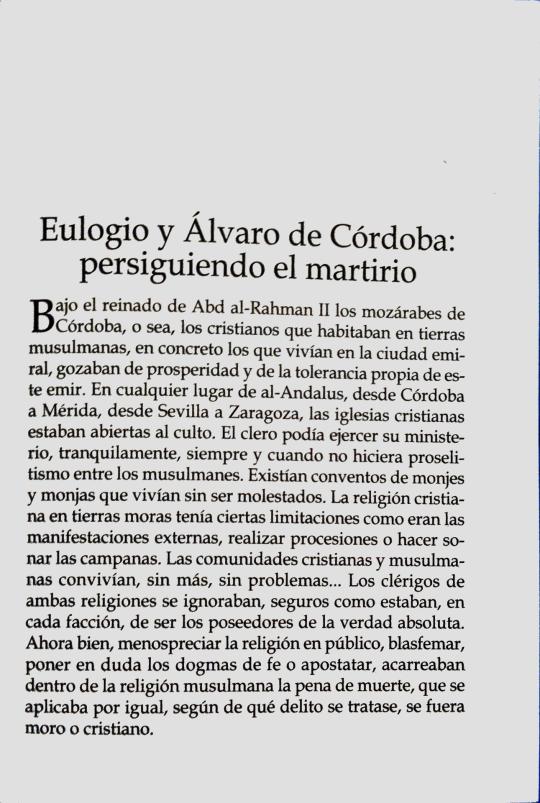
Eulogio and Álvaro de Córdoba: pursuing martyrdom
Under the reign of Abd al-Rahman II the Mozarabs of Córdoba, that is, the Christians who lived in Muslim lands, specifically those who lived in the emiral city, enjoyed prosperity and the tolerance typical of this emir. Anywhere in al-Andalus, from Córdoba to Mérida, from Seville to Zaragoza, the Christian churches were open for worship. The clergy could exercise his ministry, quietly, as long as he did not proselytize among the Muslims. There were convents of monks and nuns who lived without being bothered The Christian religion in Moorish lands had certain limitations such as the external manifestations, carrying out processions or ringing the bells. The Christian and Muslim communities lived together, without further ado, without problems... The clerics of both religions ignored each other, sure as were, in each faction, to be the possessors of the absolute truth. Now well, belittling religion in public, blaspheming, questioning dogmas of faith or apostatizing, carried within the Muslim religion the penalty of death, which was applied equally, depending on what crime it was, whether if the person was Moor or Christian.
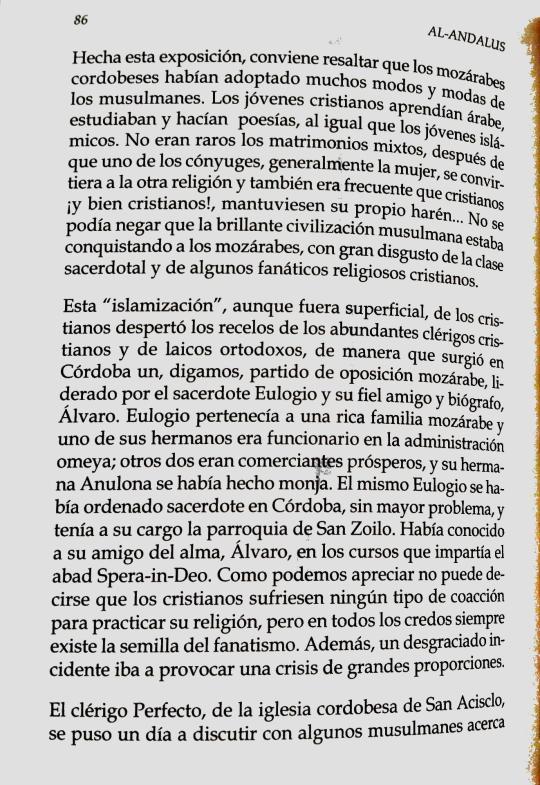
Having made this exposition, it is worth highlighting that the Mozarabs of Cordoba had adopted many ways and fashions of the Muslims. Young Christians learned Arabic, studied and wrote poetry, just like the Islamic youth. Mixed marriages were not uncommon, after one of the spouses, usually the woman, converts to the other religion and it was also common for Christians, and very Christians, to maintain their own harem... It could not be denied that the brilliant Muslim civilization was conquering the Mozarabs, to the great displeasure of the priesthood class and some Christian religious fanatics.
This "Islamization", even if it was superficial, of the Christians aroused the suspicions of the abundant Christian clerics and Orthodox laymen, of way that a, let's say, Mozarabic opposition party emerged in Córdoba, led by the priest Eulogio and his faithful friend and biographer, Álvaro. Eulogio belonged to a rich Mozarabic family and one of his brothers was official in the Umayyad administration; two others were merchants prosperous, and his sister Anulona had become a nun. Eulogius himself had been ordained a priest in Córdoba, without much problem, and had his charge of the parish of San Zoilo. He had met his soul friend, Alvaro in the courses taught by Abbot Spera-in-Deo. As we can see, It can be not said that Christians suffered type of coercion to practice their religion, but in all faiths there is always the seed of fanaticism. Furthermore, an unfortunate incident was going to cause a crisis of great proportions.
The clergyman Perfecto, from the Cordoban church of San Acisclo, one day began to argue with some Muslims about
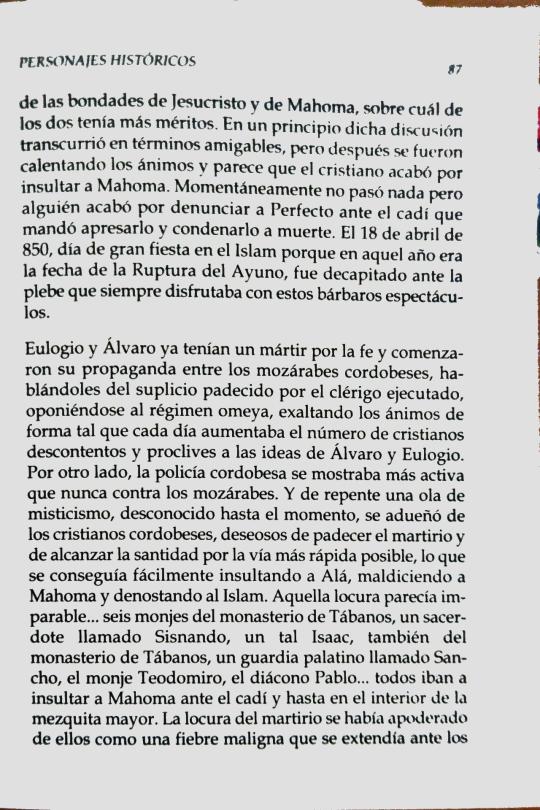
of the goodness of Jesus Christ and Muhammad, about which of the two had more merits. At first the discussion was on friendly terms, but later tempers were heating up and it seems that the Christian ended up insulting Muhammad. Momentarily nothing happened but someone ended up reporting Perfecto to the the cadi who ordered him to be arrested and sentenced to death. On April 18, 850, day of great holiday in Islam because that year was the date of the Breaking of the Fast, it was beheaded before the plebs who always enjoyed these barbaric spectacles.
Eulogio and Álvaro already had a martyr for the faith and began their propaganda among the Mozarabs of Cordoba, telling them about the torture suffered by the clergyman executed, opposing the Umayyad regime, raising spirits in such a way that every day the number of discontented Christians inclined to the ideas of Álvaro and Eulogio. On the other hand, the Córdoba police were more active than never against the Mozarabs. And suddenly a wave of mysticism, unknown until moment, took over the Christians of Cordoba, eager to suffer the martyrdom and achieving sainthood in the quickest way possible, which was achieved easily insulting Allah, cursing Muhammad and reviling Islam. That madness seemed unstoppable...six monks from the Tábanos monastery, a priest named Sisnando, a certain Isaac, also from the Tábanos monastery, a guard palatine named Sancho, the monk Teodomiro, the deacon Pablo... they all went to insulting Muhammad before the qadi and even inside the main mosque. The madness of martyrdom had taken hold of them like a malignant fever that spread before the
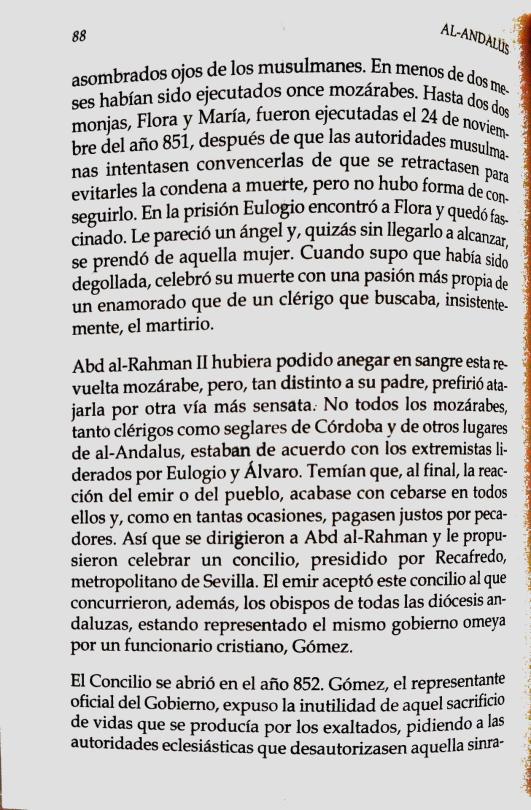
amazed eyes of the Muslims. In less than two months they had been eleven Mozarabs executed. Even two nuns, Flora and María, were executed on November 24, 851, after the Muslim authorities tried to convince them to recant to avoid the death sentence, but there was no way to achieve it. In prison Eulogio found Flora and was fascinated. It seemed like a angel and, perhaps without reaching him, he fell in love with that woman. When knew that she had been beheaded, he celebrated her death with a greater passion typical of a lover than of a clergyman who was insistently seeking, the martyrdom.
Abd al-Rahman II could have drowned this revolt in Mozarabic blood, but, so different from his father, he preferred to tackle it by another sensiblebway. Not all the Mozarabs, both clerics and laymen of Córdoba and from other places in al-Andalus, agreed with the extremists led by Eulogio and Álvaro. They feared that, in the end, the emir's reaction or the town, ended up attacking all of them and, as in so many sometimes, the righteous paid for sinners. So they approached Abd al-Rahman and proposed holding a council, presided over by Recafredo, metropolitan of Seville. The emir accepted this council to which, in addition, the bishops of all the Andalusian dioceses attended, the Umayyad government itself being represented by a Christian official, Gómez.
The Council opened in the year 852. Gómez, the official representative of the Government, exposed the futility of that sacrifice of lives that occurred by the exalted, asking the ecclesiastical authorities to disavow that non-
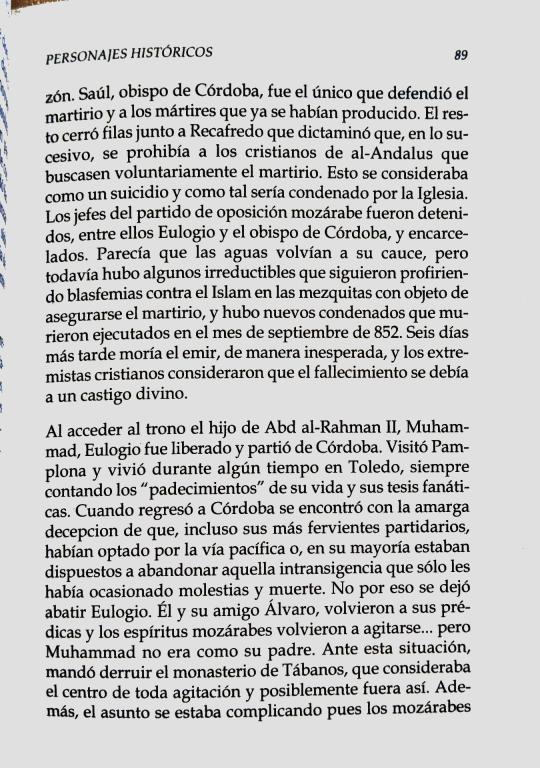
sense. Saúl, bishop of Córdoba, was the only one who defended martyrdom and the martyrs that had already occurred. The rest closed ranks with Recafredo who ruled that, from now on, the Christians of al-Andalus were prohibited from voluntarily seek martyrdom. This was considered suicide and as such he would be condemned by the Church. The leaders of the Mozarabic opposition party were arrested, among them Eulogio and the bishop of Córdoba, and imprisoned. It seemed that the waters were returning to their channel, but there was still some irreducibles who continued uttering blasphemies against Islam in the mosques in order to ensure martyrdom, and there were new convicts who were executed in the month of September 852. Six days later the emir died, unexpectedly, and the Christian extremists considered that the death was due to divine punishment.
When Abd al-Rahman II's son, Muhammad, acceded to the throne, Eulogius was released and left Córdoba. He visited Pamplona and lived for some time in Toledo, always recounting the "sufferings" of his life and his fanatical theses. When he returned to Córdoba he was met with the bitter disappointment that, even his most fervent supporters had opted for the peaceful route or, for the most part, were willing to abandon that intransigence that had only caused inconvenience and death. That's not why Eulogio let himself be discouraged. Him and his friend Álvaro, they returned to their preachings and the Mozarabic spirits stirred again... but Muhammad was not like his father. Faced with this situation, he ordered the demolition of the Tábanos monastery, which he considered the center of all unrest and possibly it was like that. Furthermore, the matter was becoming complicated because the Toledoan
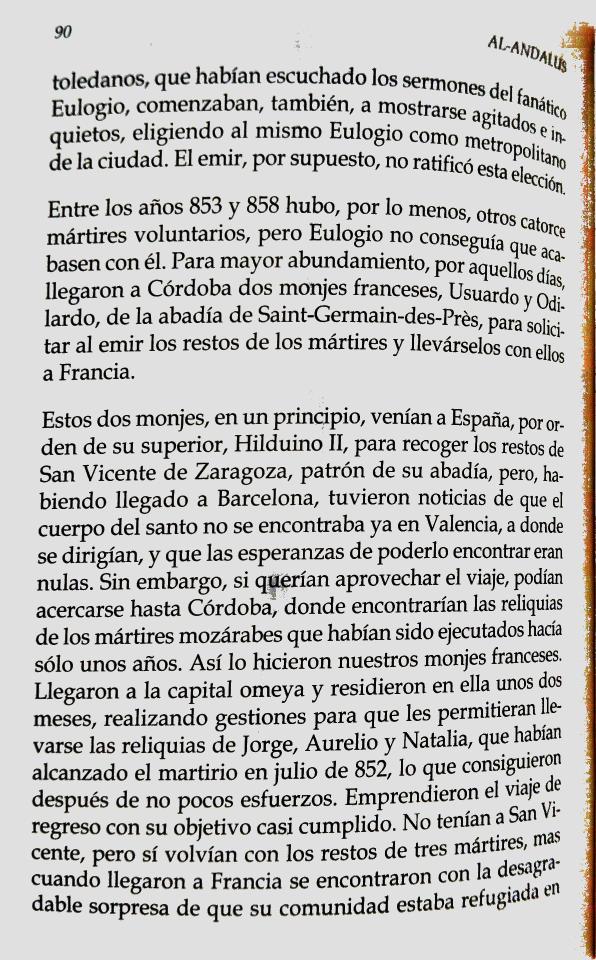
Mozarabs who had listened to the sermons of the fanatic Eulogio, were also beginning to appear agitated and restless, choosing Eulogio as metropolitan of the city. The emir, of course, did not ratified this election.
Between the years 853 and 858 there were at least fourteen other martyrs volunteers, but Eulogio couldn't get them to finish him off. For more abundance, in those days, two French monks arrived in Córdoba, Usuard and Odilard, from the abbey of Saint-Germain-des-Près, to request the remains of the martyrs from the emir and take them with them to France.
These two monks, at first, came to Spain, by order of their superior, Hildouin II, to collect the remains of S. Vicente de Zaragoza, patron of his abbey, but, having arrived in Barcelona, they had news that the saint's body was no longer in Valencia, where it was led, and that the hopes of being able to find him were zero. However, if they wanted to take advantage of the trip, they could go to Córdoba, where they found the relics of the Mozarabic martyrs who had been executed only a few years ago. This is what our French monks did. They arrived in the Umayyad capital and lived there for about two months, taking steps to allow them to take the relics of Jorge, Aurelio and Natalia, who had achieved martyrdom in July 852, what they achieved after quite a bit of effort. They started the journey back with his goal almost accomplished. They did not have S. Vicente, but they did returned with the remains of three martyrs, but when they arrived in France they found themselves with the unpleasant surprise that their community was refugee in
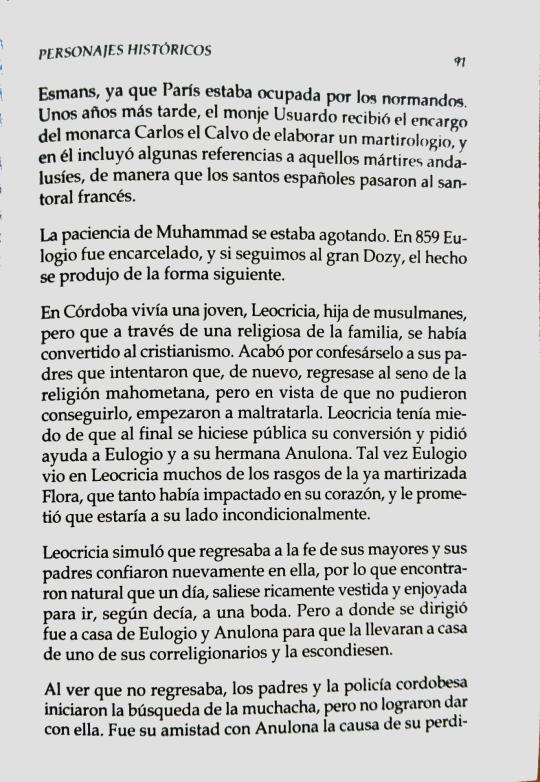
Esmans, since Paris was occupied by the Normans. A few years later, the monk Usuard received the commission from the monarch Charles the Bald to prepare a martyrology, and in it he included some references to those Andalusian martyrs, so that the Spanish saints passed to the French saints.
Muhammad's patience was wearing thin. In 859 Eulogio was imprisoned, and if we follow the great Dozy, the event occurred in the following way.
In Córdoba there lived a young woman, Leocricia, daughter of Muslims, but through a nun in the family, had converted to Christianity. She ended up confessing it to his parents who tried to get her to return to the bosom of the Mohammedan religion, but since they could not obtain it, they began to mistreat her. Leocricia was afraid that in the end her conversion would become public and asked Eulogio and his sister Anulona for help. Maybe Eulogio saw in Leocricia many of the traits of the already martyred Flora, who had so much shocked in his heart, and he promised that he would be by his side unconditionally.
Leocricia pretended to return to the faith of her elders and her parents trusted again in it, so they found it natural that one day, it would come out richly dressed and jeweled to go, as she said, to a wedding. But where she went to Eulogio and Anulona's house so they could take her to the house of one of her coreligionists and hid her.
Seeing that she did not return, the parents and the Córdoba police began the search of the girl, but they could not find her. It was his friendship with Anulona that cause of her perdi-

tion because she spent a day with her, and the servant who was to pick her up to return to her hiding place, she did not arrive until dawn. Fearing to be recognized if she went out at that time, she decided to stay one more day with her friend, until nightfall. But a spy or simply someone who knew where the fugitive was, told the cadi who sent soldiers to arrest Leocricia and Eulogio, who at that time was reaching his sister's house.
Brought before the cadi, Eulogio declared that he had taken care of instruct the young woman in Christianity in the same way as he would with the Muslim leader if he asked. Leocricia, confessed of apostasy, was sentenced to death, but Eulogio was only sentenced to be whipped.
Perhaps out of pride, Eulogio did not settle for the punishment of whipping. Everyone died before him! All his life preaching martyrdom, martyrdom that many of his supporters had suffered with joy, and he I was going to be less holy than them! It was something he couldn't consent. He was taken to the council room where one of the dignitaries who knew him since he was young, he asked him why he had such a desire to die, if there was no something in his life worth keeping. If he retracted of his continued blasphemies against Muhammad and Islam, he would be forgiven immediately.
The cultured Muslim society felt more pity than hatred for the fanatics and they also felt that they had to proceed to shed blood with those who seemed to have gone crazy. But for Eulogio there was no longer a possible retreat. If he had retracted, the contempt of his people would be even worse than death. So he stood firm
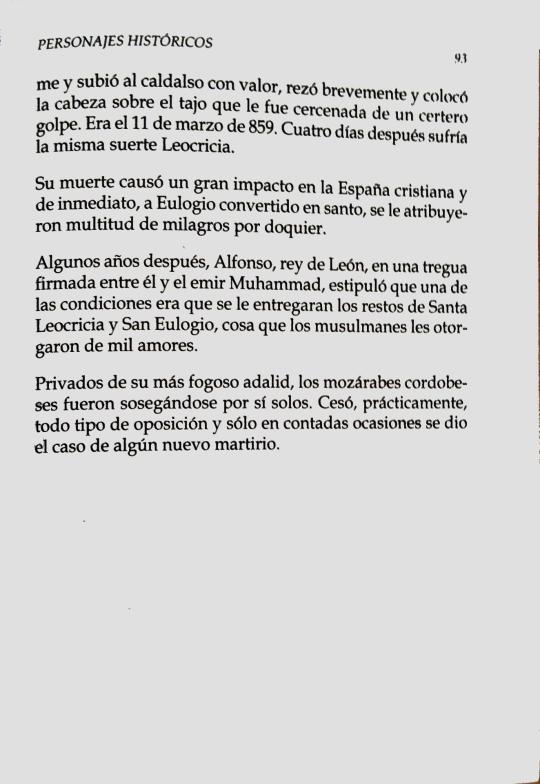
and he bravely climbed into the scaffold, prayed briefly and placed his head on the slash that was severed with a well-aimed blow. It was March 11, 859. Four days later Leocricia suffered the same fate.
His death caused a great impact in Christian Spain and immediately, Eulogio became a saint, a multitude of miracles were attributed to him everywhere.
Some years later, Alfonso, king of León, in a truce signed between him and the emir Muhammad, stipulated that one of the conditions was that the remains of S. Leocricia and S. Eulogio would be handed over, something that Muslims gave them a thousand loves.
Deprived of their most fiery champion, the Mozarabs of Córdoba were calming down on their own. Practically all types of opposition ceased and only on rare occasions there was the case of a new martyrdom.
#al andalus. historical figures#al andalus. personajes históricos#al andalus#book scans#al andalus history#bookblr#historyblr#spanish history#emirate of cordoba#eulogio de córdoba#álvaro de córdoba#emirato de córdoba
15 notes
·
View notes
Text
8th part of the bookscans of Al Andalus. Historical Figures, here's the previous part

discovered by others. In this case his rival was Mu'min ibn Said, who did not hesitate to say that the thunders of the “heavenly vault” created by Abbas ben Firnas were no more than his own farts.
The anaphoric clock construction technique is also due to this inventor , a variant of the Greek clopsydra. It must be taken into account that for the measurement of time was very important to Muslims because they indicated the hours of prayers.
However, his most brilliant stroke, according to Levy Provençal, was the attempt to wanting to fly, becoming the most remote precursor of aviation, if not We take into account the myth of Icarus, that Greek who with wings of wax He got too close to the sun and it melted them. ;It could be considered the first aviator? Yes, it is possible, but he was about to pay for it with his life. He made a cover for the entire body, to which he sewed a multitude of feathers of silk and to which he added two movable wings, proportionate to his height and Dressed in this way, he jumped into the void from some rocks in Rusafa. The Expectation of this "flight" is easy to imagine. Before the astonished eyes of the peasants, the bird-man took flight, glided for a few moments... and fell with a crash, a little beyond his starting point. Fortunately, he did not suffer a major physical disaster, although this attempt failure to emulate the birds caused great joy to his usual enemy, Mu'min ibn Said, who did not shy away from saying ironically: "He wanted to surpass the griffin in his flight and he only had on his body the feathers of an old vulture," according to Eslava Galán in one of his works. Really, it seems like he just got hurt

the rear, since he did not realize that birds, when landing, use the tail, and he had not made a tail! His audacity served to ensure that this attempted flight was collected in the Arabic literary texts and which were later transmitted to the Castilian romances.
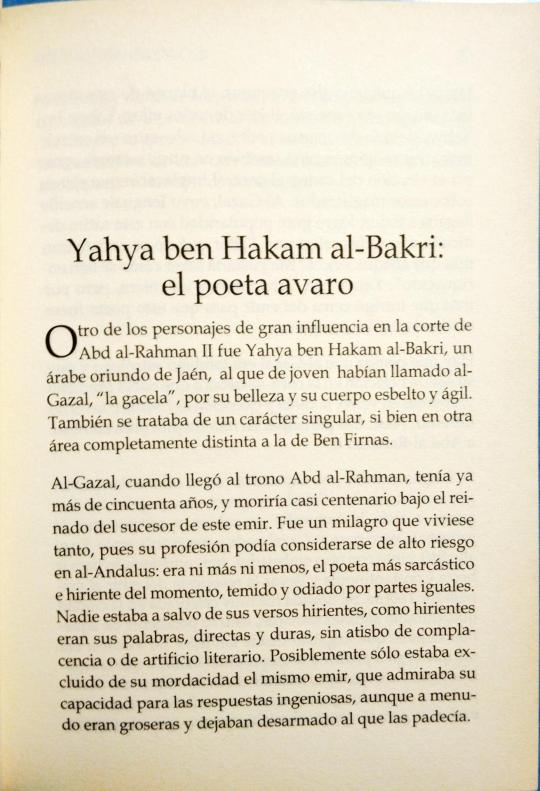
Yahya ben Hakam al-Bakri: the misery poet
One of the most influential figures at the court of Abd al-Rahman II was Yahya ben Hakam al-Bakri, an Arab from Jaén, who as a young man had called al-Gazal, “the gazelle", for its beauty and its slender body and agile. It was also a unique character, although in another area completely different from that of Ben Firmas.
Al-Gazal, when Abd al-Rahman came to the throne, was already over fifty years old, and he would die almost a hundred years old under the reign of this emir's successor. It was a miracle that he lived so long, since his profession could be considered high risk in al-Andalus: it was neither more nor less, the most sarcastic and hurtful poet of the moment, feared and hated in equal parts. No one was safe from his hurtful verses, as hurtful as they were. His words, direct and harsh, without a hint of complacency or literary artifice. Possibly only the emir himself, who admired his capacity for witty responses, although they were often rude and left the sufferer unarmed
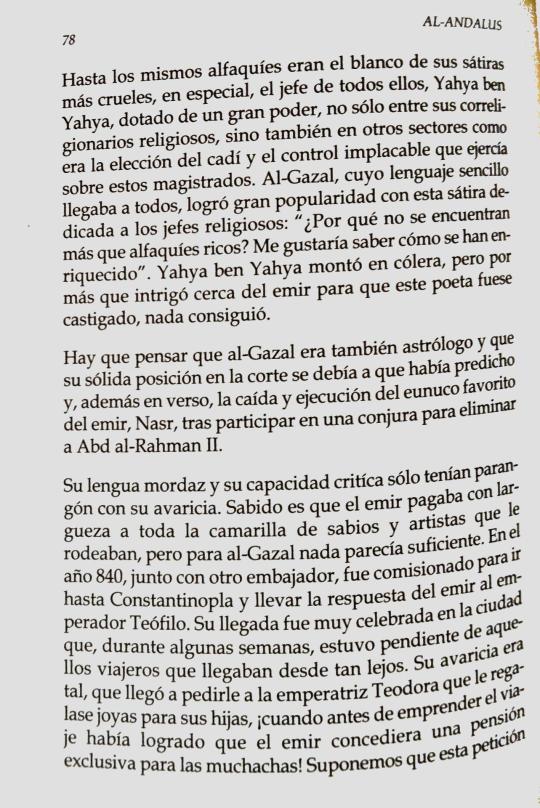
Even the alfaquíes themselves were the target of their cruelest satires, in especially, the chief of them all, Yahya ben Yahya, endowed with great power, did not only among their religious coreligionists, but also in other sectors such as was the choice of the cadi and the implacable control he exercised over these magistrates. Al-Gazal, whose simple language reached everyone, achieved great popularity with this satire dedicated to religious leaders: "Why don't you find more than rich alfaquíes? I would like to know how they have become rich." Yahya ben Yahya was furious, but no matter how much he intrigued of the emir for this poet to be punished, he achieved nothing.
It must be considered that al-Gazal was also an astrologer and that his solid position in the court was because he had predicted and, also in verse, the fall and execution of the emir's favorite eunuch, Nasr, after participating in a plot to eliminate to Abd al-Rahman II.
His biting tongue and critical ability were only matched by his greed. It is known that the emir paid lavishly the entire clique of wise men and women artistsb around him, but for al-Gazal nothing seemed enough. In the year 840, together with another ambassador, was commissioned to go to Constantinople and take the emir's response to Emperor Theophilus. His arrival was greatly celebrated in the city that, for a few weeks, was attentive to those travelers who came from so far away. His greed was such that he even asked the Empress Theodora to give him jewels for his daughters, when before undertaking the trip had managed to get the emir to grant an exclusive pension for the girls! We assume that this request

Imust have surprised the empress quite a bit. That an ambassador of the prosperous al-Andalus, whose prince was known for his generosity, making such a demand would cause a more than dubious impression on the noble lady about that begging poet and ambassador!
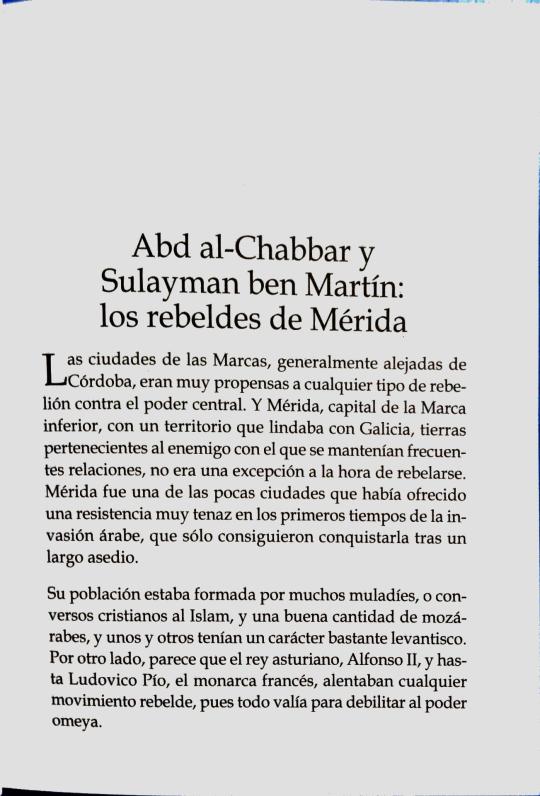
Abd al-Chabbar and Sulayman ben Martin: the rebels of Merida
The cities of the Marches, generally far from Córdoba, were very prone to any type of rebellion against central power. And Mérida, capital of the Lower March, with a territory that bordered Galicia, lands belonging to the enemy with whom frequent relations were maintained, not was an exception when it came to rebelling. Mérida was one of the few cities which had offered very tenacious resistance in the early days of the Arab invasion, which they only managed to conquer after a long siege.
Its population was made up of many muladíes, or Christian converts to the Islam, and a good number of Mozarabs, and both had a character quite rebellious. On the other hand, it seems that the Asturian king, Alfonso II, and even Louis the Pious, the French monarch, encouraged any rebellious movement, because everything was worth to weaken the Umayyad power.

In the year 828 the inhabitants of Mérida, grouped under the command of two insurgents, the Berber Abd al-Chabbar and the muladi Sulayman Ben Martín, They broke all the ties they maintained with the central power and murdered the legal governor of the city. They became masters of the situation, but after a year Abd al-Rahman II, at the head of a column of repression, laid siege to the city without being able to surrender it. Then we proceeded as usual in those times: all the crops were burned and the land was devastated in the surrounding areas so that the rioters could not get supplies, but the emir,'s troops had to withdraw without any success. That couldn't stay like this and in 830 a new siege was carried out.
Whether because the situation was compromised, or because they had not yet recovered from the previous site, the inhabitants of Mérida had to hand over hostages and accept a governor loyal to Córdoba, Harith ben Bazi. But this mission can be said to have only been a flower of a day, since in the years following, Abd al-Rahman II had to besiege the square on numerous occasions until they managed to pacify the Lower March and make Mérida return to the Umayyad obedience. It is believed that this was achieved around the year 834. In any case, to ensure the position of the loyal troops that remained in the rebellious city, in 835 a fortified redoubt was built, surrounded by a wall that was twelve cubits wide.
The two rebel leaders had to flee. It was not possible to stay in Mérida without falling into the hands of successive loyal governors who would have ended with them. At first both sought refuge in Badajoz, and later

and always fleeing, in some castles in lower Guadiana. Eventually, they ended up separate and look for life each on their own. The muladí Sulayman ben Martín headed north and settled in the castle of Santa Cruz de la Sierra, near Trujillo, but was defeated and killed by Umayyad troops in the year 834. And there his story ended, while that of his fellow Berber citizen was going to be, to say the least, much more picturesque. The Berber Abd al-Chabbar decided to stay in the Guadiana valley, but year after year, the Córdoba troops harassed him, so he had to retreat towards the south with his supporters, all Berbers too, accompanied by their families. He was luckier than his companion and defeated the inhabitants of Beja, who came out to face him. But that was not life, and in the end he settled down next to the Atlantic, district of Ocsonoba, in the castle of Monte Sacro, approximately near the present-day Portuguese city of Faro. But he didn't find the longed-for tranquility there either. In the year 838 the Umayyad army removed him from this position and decided to go to Galicia. He wrote to Alfonso II, the Asturian king, requesting his understanding and support and the monarch of Oviedo agreed to settle in those lands. He sent him to his court and gave him a fief castle on the Galician border, possibly located between Porto and Lamego. It's possible to suppose that Alfonso's generosity had some counterpart and Abd al-Chabbar, on numerous occasions, carried out raids against the Muslims, proving very useful to the Christian king in those border lands.

Time passed and everything seemed to be fine between the Berber and Alfonso, but feeling himself getting older, the rebel from Mérida became remorseful. He was acting in favor of Christians, against their origin and their religion... perhaps he didn't have much time to live and it was better to make amends while he still had time. In the greatest of secrets he sent a letter to the emir Abd al-Rahman II, asking for forgiveness for having behaved as he did, and the emir was quick to comply with her wishes. He was forgiven, but while he held dealings with Córdoba, Alfonso II found out about all these movements of his former ally and sent him urgently to Oviedo. Abd al-Chabbar did not attend the appointment, claiming that he was ill. The Asturian monarch, convinced that "the goat always shoots into the mountains", did not doubt that his vassal had returned to the Umayyad cause and decided to fight him in his own fiefdom. The sick, who was not such, made a sortie on the enemy camp, and despite who was, like all Arabs, an accomplished horseman, the horse threw him. Fell wounded, he was taken prisoner and died in the year 840, in the month of May. Abd al-Chabbar's entire family, by order of Alfonso II, was transferred to Galicia. This Berber had a sister, whose beauty was known and admired by everyone who saw her and that it would help her marry a Galician nobleman, after, of course, she converted to Christianity. This marriage had a son, who according to the Arab historian Ibn Hayyan, would later become a bishop of Santiago de Compostela.
Of course, "the ways of the Lord are infinite"!
#al andalus. historical figures#al andalus. personajes históricos#bookblr#historyblr#al andalus#al andalus history#spanish history#book scans#emirate of cordoba#abbás ibn firnás#yahya ibn hakam al-bakri#abd al-chabbar#sulayman ibn martin
6 notes
·
View notes
Text
6th part of the bookscans of Al Andalus. Historical Figures, here's the previous part

The following year a very serious incident occurred in the suburb, and according to custom, al-Hakam acted summarily, executing all possible guilty suspects through the infamous crucifixion.
As if that were not enough, the mood of the population in general, an increase in the taxes that, on top of that, a Christian, the so-called Count Rabi, collected, ended up for exasperating everyone. And the spark of rebellion broke out over an apparently trivial matter, as happens on so many occasions. A soldier of the guard emir had his sword polished and it seemed to him that the swordsmith in the suburb did not attend to him with sufficient alacrity, so he killed him by piercing him with his sword in question. Al-Hakam was hunting outside Cordoba and upon returning, passing through the conflictive neighborhood, was booed. His guard arrested ten rioters and, without mercy, they were immediately crucified. The emir had barely arrived at his palace when the entire suburb was up in arms. Businesses were closed and the tents, and with sticks, stones, knives, and everything they had within their reach, artisans, merchants, and the general public headed to the doors of the Alcázar with threatening intentions and the design of demolishing them.
In those moments of anguish in the Alcázar, when his fate presented itself doubtful in the face of those angry mobs, only al-Hakam seemed to retain the calm. He asked his Christian page to fetch a jar of civet and with it he perfumed his hair and beard. The page asked him, astonished, how in those serious moments he could think of putting on perfume as if he were going to court a woman and the emir replied that he did it so that when the popu-

lace cut off his head to know that it was really the head of their prince and not that of any other. Measures were taken with all the speed that the committed moment required. The troops loyal to the emir ensured order in the city and the palace butler and his secretary gathered all the available forces to try to contain the rapidly advancing mobs that were leaving uniting more and more people. The emir's troops were beginning to falter in the face of what seemed an unstoppable force of the mutineers, until two of the generals from al-Hakam they managed to reach the first houses in the suburb. Then its inhabitants found themselves surrounded. The two exits of the neighborhood were taken by loyal to the emiral cause. The rout began... and the slaughter.
Al-Hakam gave orders that no mercy be shown to the rioters and for three the looting and massacre continued, and no one knows what it could had happened if the minister Ibn Mugith did not advise the emir to cease in that horrible carnage. The suburb was closed so that no one could leave there until al-Hakam passed sentence or thought about what to do with the rebel subjects. The solution was still terrible, as terrible as three hundred notables of the suburb would be crucified and the rest of the inhabitants who had survived would preserve their lives in exchange for immediately abandoning Córdoba. The suburb would be completely demolished, plowed and planted so that no one could build a house or a habitation there. None of al-Hakam's successors dared, until the end of the 10th century, to contravene that now distant prohibition dictated by the emir and the suburb remained, for

a long time, like a desolate and dead place in which it seemed impossible there would have been so much life.
The inhabitants of the suburb, "rabadis" as they would be known, had to abandon house, business and city in the first fortnight of April 818. Only the fuqahāʾ and their families were freed from this expulsion, much to the dismay of al-Hakam, knowing as he knew that if they had not been the direct instigators of the rebellion, they encouraged it and did nothing to calm things down. It is not well known how many people were banished from the suburb, it is believed that perhaps there were about 20,000, since it was a very populous neighborhood, although the figure may have been a bit exaggerated. And there begins the odyssey of the “rabadis”, who showed themselves to be accomplished adventurers, forced, no doubt, by the need.
Some went to take refuge in Toledo, a city always willing to welcome to all those who showed themselves against the central power. But they feared that the anger of that vengeful emir reached them, so they decided to flee further away, as far as to cross the sea. The Rabadis, with their families, left towards the Mediterranean coast, not without suffering the assault of the unscrupulous in their modest convoys in which they carried the few belongings they saved from the merciless looting to which they had already been subjected. Some went to North Africa and settled among the Berber tribes. In this region there were few cities and Prince Idris II was looking for inhabitants who could populate the city of Fez that their father had founded. It would not

take much time to increase this population with a new city, very close to the one that already existed and spread the word that everyone who came to populate both cities would be welcomed with open arms. Many Rabadis, with their families, moved there and very soon the new foundation of Idris II was known as Madinat al-Andalusiyyin, the “City of the Andalusians”. To this city they took the rabadis their knowledge of gardening and agriculture, crafts and architecture, as well as as their forms of citizen life. But this was not their greatest feat of those banished.
Part of them set out to sail the Mediterranean, dedicating themselves to privateering and piracy to survive. Although the Rabadis were not sailors, it is very possible that they they were accompanied by Valencian or Andalusian sailors, muladíes most likely, and that together they would undertake that adventure.
One day they docked in front of beautiful Alexandria, in those days subjected to fighting, that were taking place throughout Egypt, among the governors appointed by the caliph. The Rabadis became strong in the city and with the help of a faction Arab, the Lajmis, and the followers of a puritan Islam, created a kind of independent republic that they would maintain for more than ten years.
In vain the inhabitants of Alexandria tried, on more than one occasion, to get rid of these upstarts who had become masters of their city. Finally, in May 827, the governor Abd Allah ben Tahir, besieged them and after several days of siege, the Rabadides surrendered. They were allowed to go, but

they could not take any of their slaves and had to compromise that they would not dock in any port that was in Abbasid territory.
Thus they found themselves expelled from Egypt, as they had already been expelled from Córdoba, and they began the journey again, this time heading towards the island of Crete, which belonged to the Byzantine Empire. In command of that expedition that sought a place to settle, there was a man from Córdoba from Llano de los Pedroches, called Abu Hafs Umar al-Balluti. They landed on the island and occupied it in their whole. Abu Hafs al-Balluti founded a dynasty there that remained on the island for one hundred and thirty-four years, until the year 961.
They repelled incessant Byzantine attacks that wanted to recover Crete, until that the general Nikephoros Phocas managed to recapture the island for the Byzantine emperor Roman II.
Back at sea, those already distant Andalusians, for more than a century and medium, frightened the entire navigation of the central and eastern Mediterranean, also acting with great audacity in the Aegean islands.

Ziryab: the singer of Baghdad
A somewhat peculiar character from Muslim Spain was Ziryab, although he wasn't a politician, nor a religious person, nor a warrior, he was going to have a capital influence on the Andalusian society, creating fashions and implementing customs and ways of life that ended up adopting Moors and Christians, and that would remain until our days.
Ziryab was called that because he had very dark skin and he was given this nickname in reference to the black plumage of a bird, the blackbird, but its real name was Abu-l-Hasan Ali ben Nafi. He was born in Mesopotamia and was a freedman of the Abbasid caliph al-Mahdi. From a very young age he showed to be gifted, in a privileged way, for singing and was a disciple of another celebrity in the field of music, the singer of the Baghdad court, Ishaq al-Mawsilí. Very soon he became so famous that the Great Caliph Harun al-Rashid asked the teacher to bring his disciple to court to hear him sing.
There are many legends about this performance. One of the best known is the that Ziryab, before the caliph, very sure of himself, told him that he knew how to sing what other great singers knew but, who also sang, what no one knew sing. If the caliph so desired, he would put in his ears

a music and a song that no one had heard before. Harun al-Rashid was surprised and intrigued and wanted me to act for him, interpreting those unknown melodies.
It is said that Ziryab did not use the traditional lute as accompaniment, but who used an instrument of his invention. It was a kind of five-string guitar, the first, the third and the fifth were made with lion's guts; the second and fourth were made of red silk. To press them, instead of the typical pick of wood, he used the claw of an eagle.
Harun-al Rashid was fascinated by what he heard and told the singer that he returned the next day to perform, again, for him. But Ziryab didn't returned to the palace in Baghdad. What had happened for the musician to not coming back? Well, his master felt deep envy of the success of his disciple. He understood that he was going to take away his place as a favorite singer in the court and threatened to kill him. Ziryab, fearing for his life, decided to leave from Baghdad as soon as possible
The sad days of exile as a traveling musician began for him. For some time he lived in Cairo, crossed the deserts of Egypt and Libya and he settled in Qayrawan, a city that had nothing to do with the splendor of Baghdad or the refined Córdoba. But wherever he went, those who heard him singing could never forget the timbre of his voice and the harmony of his compositions. And so it was that through another musician, less jealous than his mas-

ter!, the Cordoban Jew Abu-l-Nasr Mansur, reached the ears of al-Hakam I the mastery of Ziryab and sent for him. Al-Hakam I, like all the emirs and, later, Andalusian caliphs, was a great lover of music and poetry and himself a notable poet. Ziryab embarked immediately to Algeciras. There, as soon as he disembarked, he received news that the emir had just died and became disheartened, thinking that his good luck was ending. But Abd al-Rahman II, son and successor of al-Hakam, let him know that he maintained the contract that his father had offered him and sent him gifts of such magnificence that the singer was clear that he would remain in al-Andalus forever. The emir received him with the greatest attention and not only that: he assigned him a fabulous pension for the time, 200 gold dinars a month, in addition to providing him with a house and servitude, giving him some land in the countryside of Córdoba, which was very productive, and complete his offering with two hundred sextars of barley and one hundred of wheat to maintain his house and his family. There was not in all Muslim world another poet, musician, singer or scholar who was better paid than Ziryab, and the splendid remunerations of which he was the object, extended, even further, his fame everywhere. In truth it must have been an exceptional being for the emir treated him with such kindness!
But to better understand the generosity of Abd al-Rahman II it is interesting to know something about what his life and his court were like, in which he adopted all the royal forms of the Court of the Abbasids. His father had left him the Treasury coffers completely packed, which allowed the new emir to dedicate

to acquire the most precious merchandise that arrived to Córdoba brought by Jewish, Slavic and Iraqi merchants.
Abd al-Rahman II was an unrepentant lover and admirer of women. Of all Europe and also from the East, beautiful young women will arrive, always virgins to the harem of the emir, who is said to have had forty-five male children and forty-two daughters. Some of his many concubines managed to reach just fame for her beauty, careful education and talent. Such is the case of the three young people known as the “Medinese”, not because they were natives of this city, what's more, one of them was Spanish, but all three had been educated in a perfect Arab culture. They were magnificent singers, versifiers and experts in Medinese music and entertained the leisure of their lord who appreciated them in such a way. So for them he had a special pavilion built inside the Alcázar.
A man like the emir, lover of all pleasures, both the sensual ones like intellectuals, it was not surprising that he appreciated moving art and only one of Ziryab, who arrived in al-Andalus in the year 822, with four children who, with over time, they would continue his work, and he stayed until his death in 857. In these thirty-five years the emir and he always maintained cordial relations and they appreciated and respected each other.
But Ziryab's activities were not only limited to music, but his genius manifested as a profound innovator of the Muslim society of the time. He created a conservatory... and a beauty institute, because Ziryab was a true and refined dandy.
#al andalus. historical figures#al andalus. personajes históricos#book scans#al andalus#historyblr#bookblr#al andalus history#spanish history#rabadies#rabadid dinasty#al hakam i#al hakam i of córdoba#emirate of cordoba#emirate of crete#abu hafs al-balluti#abd al rahman ii#abd al rahman ii of córdoba#zyriab#abu-l-hasan ali ibn nafi#zyriab the singer of baghdad#al-balluti
11 notes
·
View notes
Text
Fifth part of the bookscans of Al Andalus. Historical Figures, here's the previous part

expelled from their homes, since they had not surrendered peacefully, but had fought.
Charlemagne, chastened, realized that the pacts signed with the Muslim lords of northern Spain deserved no trust. He would never set foot on the Peninsula again, and subsequently dedicated itself to strengthening its borders with Hispanic Islam. For this he created the kingdom of Aquitaine, whose mission consisted of not taking our eyes off the activity of the Muslims of the places bordering Gaul.
From the disaster suffered by Charlemagne in Roncesvalles we have remains what some consider the most beautiful song of deeds of literature, La Chanson de Roland, an authentic gem of the epic poetry. Within the Spanish Ballads we find two romances that have this fact as their theme: Of the battle of Roncesvalles and the Romance of Doña Alda. The Basques also preserve a song dedicated to Roncesvalles, the Altabizaren cantua, which according to the Irishman Macnab, was written in the same century in which this event took place. But Ibn al-Arabí, who had been the originator of this whole story, was not reflected in any of these beautiful romances!

Amrus ben Yusuf: the muladí of Huesca
Muladí comes from an Arabic word that translates as "mixed race or foreigner", and was applied to those Christians who converted to Islam and continued living among the Muslims. There were many who decided to abandon Christianity, possibly for practical reasons, including stopping paying taxes, or reaching a position of social relevance among the new owners of the country and there were not a few who achieved it. There was also sincere converts, since in those centuries the roots of the Christianity was not as deep as it may seem.
This was the case of our character, Amrus ben Yusuf, whom the Christian chronicles will know him as Amorroz, born in Huesca and one of the staunchest defenders of the policies of al-Hakam I. After the death of Abd al-Rahman I, his son Hisham, a very pious emir, introducer of the Maliki doctrine in Spain, and who Driven by his religious fervor, he dedicated himself to waging war on the Northern Christians. Al-Andalus remained at peace and therefore the new emir was able to dedicate himself

to harass the Asturian monarchy. But his reign was to be very short, just seven years, and was succeeded by his second son, al-Hakam I.
But the arrival of the new emir was greeted with rebellions in all the border marches. In the most remote areas of Córdoba, the authority of the emir hardly represented anything and the governors lived in a regime of almost total independence. The insurrections against the power of the emirate were more than frequent and al-Hakam had the unfortunate luck to have to face them all. In this hard task, he will have a paladin who will always be at his side: Amrus, who will not hesitate to take radical measures when the matter is serious. This muladí would become famous on what was known as the “day of the pit.”
In the year 797, the always restless Toledo, inhabited mostly by muladíes, rose up against the Umayyad power to recognize a rebel Ubayd Allah ben Jamir, who together with a poet of Toledo, Girbib ben Abd Allah, dissatisfied with the emir, had in charge of calming down the spirits. It wasn't the first time this happen, nor would it be the last, and al-Hakam's predecessors had already had to work hard to put a stop to the rebels of Toledo.
Amrus, who at that time ruled the stronghold of Huesca, was commissioned by the emir to subdue that uprising by the means that it considers opportune. And there went Amrus willing not to disappoint his lord.

He began by eliminating the leader of the rebellion, Ubayd Allah ben Jamir, who fell into a trap prepared by him and then decided to give a lesson to the people of Toledo that they would find difficult to forget.
Amrus, according to him to avoid friction with the population, said that the best would be that, along with his troops, he would settle on a mound near the city. Towards the northwest, near the bridge over the Tagus River, rose a small fortress, possibly on the site now occupied by the Alcazar. When the enclosure was more or less finished, the emir, in agreement with Amrus, he sent an army under the command of his son, the prince Abd al-Rahman, pretending that he was going on an expedition against the Christians and that "coincidentally" had to pass near Toledo. It was a good occasion to invite the prince to visit Toledo, and Amrus, accompanied by the most important people of the city, they came out to receive him and begged him to honor them with his presence.
Abd al-Rahman seemed somewhat reluctant to accept the invitation, but In the end he agreed to it and to celebrate it the most influential mula-díes of Toledo were invited to the new fortress to celebrate a banquet in honor of the emir's son. Until then everything was more or less normal, but as the guests arrived, they became enter through a narrow passage, at the very edge of a large ditch, and the Amrus's executioners cut off their heads, while their bodies was thrown into the pit. That was the " castle of you will go and no you will come back"!
The number of those beheaded was very large. Maybe not as much as 5,000, according to some chroniclers; maybe about 700

being a very high number. What the leading class of Toledo was thus beheaded and the terrible impression produced by this event remained, for a long time, both among the Muslims and among the muladies of Toledo and from other cities.
Dozy narrates that terrible day like this: "At daybreak, a doctor that had not seen anyone leave through either of the two door, became suspicious and asked the people gathered near the entrance of the castle what had happened to the guests who had arrived early. "They must have gone out through the other door," they answered- It's strange!-the doctor then objected -; I have been for some time at the other door and I haven't seen anyone leave. After watching the steam rising above the walls, exclaimed:
Unfortunates! I swear to you that this vapor is not the smoke of a feast, but the vapor of the shed blood of your brothers, beheaded"
When things got really bad, al-Hakam knew that he could count on Amrus and so he also entrusted him with the submission of Zaragoza, the capital of the Upper March, as seditious as Toledo.
After the advent of al-Hakam, the two best generals of his father, Abd al-Karim ben Mugith and his brother, Abd al-Malik, in those moments at enmity with the new emir, they tried to evict the Aragonese chief Bahlul ben Marzuq from Zaragoza, to They settled in the city, but they did not succeed. He got a Cordoban army, and
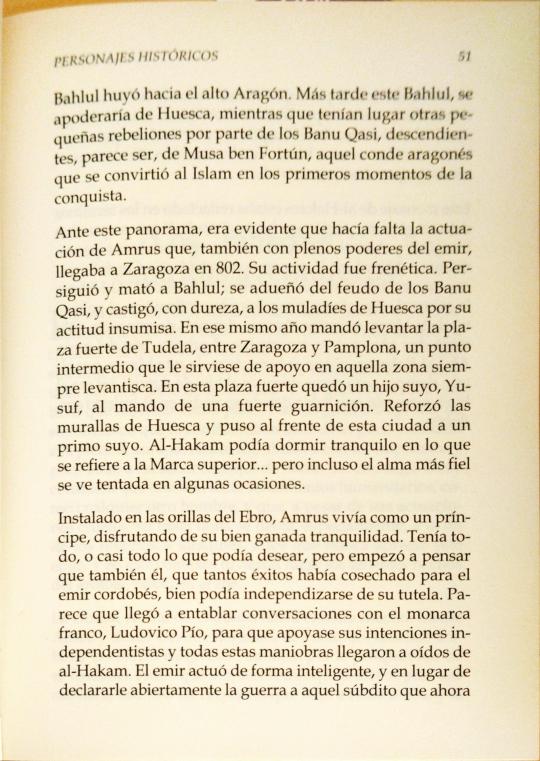
Bahlul fled towards upper Aragon. Later this Bahlul, would take over Huesca, while other small rebellions by the Banu Qasi took place, who were descendants, it seems, of Musa ben Fortún, that Aragonese count who converted to Islam in the first moments of the conquest.
Given this panorama, it was evident that the action of Amrus who, also with full powers of the emir, came to Zaragoza in 802. Its activity was frenetic. Persecuted and killed Bahlul; took over the fiefdom of the Banu Qasi, and harshly punished to the muladíes of Huesca for their rebellious attitude. In that same year he ordered the construction of the stronghold of Tudela, between Zaragoza and Pamplona, an intermediate point that would serve as support in that always upheaval area. In this stronghold there was his son, Yusuf, commanding a strong garrison. He reinforced the walls of Huesca and put one of his cousins in charge of this city. Al-Hakam could sleep peacefully when it came to the Upper March... but even the most faithful soul is tempted in some occasions.
Installed on the banks of the Ebro, Amrus lived like a prince, enjoying your well-earned peace of mind. He had everything, or almost everything he could want, but he began to think that he too, which had garnered so much success for the emir of Cordoba, could become independent of his tutelage. It seems that he came to engage conversations with the Frankish monarch, Louis the Pious, so that supported their independence intentions and all these maneuvers reached al-Hakam's ears. The emir acted intelligent, and instead of openly declaring war on that subject that now
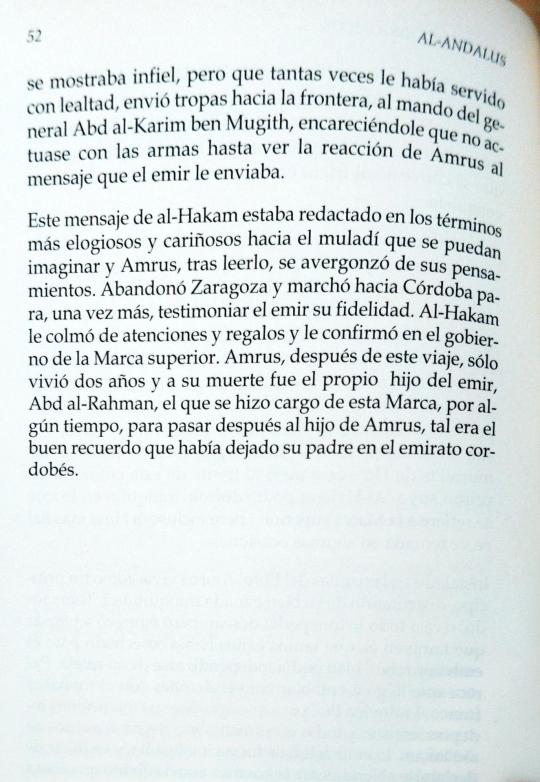
showed to be unfaithful, but that he had served him so many times with loyalty, he sent troops to the border, under the command of General Abd al-Karim ben Mugith, urging him not to act with the weapons until seeing Amrus's reaction to the message that the emir gave him.
This message from al-Hakam was written in the most praiseworthy and affectionate towards the muladí that you can imagine and Amrus, after reading it, was ashamed of his thoughts. He left Zaragoza and marched towards Córdoba to, once again, bear witness the emir his fidelity. Al-Hakam showered him with attention and gifts and confirmed him in the government of the Upper March. Amrus, after of this trip, he only lived two years and at his death the son of the emir, Abd al-Rahman, took charge of this March, for some time, to later pass to the son of Amrus, such was the good memory that his father had left in the emirate of Cordoba.

The "Rabadis": adventurous spirits
Most historians consider the emir al-Ha-kam I despotic and cruel. There is no doubt that his character was too impulsive and his justice extremely summary, but it is also true that his reign was affected by a series of rebellions and serious events that he had to repress as best he could. He never enjoyed the appreciation of his subjects who considered him inflexible, little inclined to piety, although it was not like that, abusive with taxes and little given to listening advice from no one. However, Dozy believes that he also had humanitarian feelings, like any other man, and that, despite of his cruel actions, his bad reputation was due, especially, to the wrath of the rebellious alfaquis, whom this emir never appreciated. And in this context, the terrible events of the suburb, rabad in Arabic, took place.
The emiral city of Córdoba had grown a lot. From Africa and from the East any Arabs and Berbers from the Maghreb continually arrived attracted by the prosperity of al-Andalus. The mosque had to be expanded larger to accommodate the number of believers who came to pray to it, and

The city was expanding beyond its walls. After the Roman bridge over the Guadalquivir was restored, there was no longer a problem for the population to settle in a suburb on the left bank of the river, which reached the vicinity from a village, Shaqunda, ancient Roman Secunda.
The inhabitants of this suburb were of very diverse origins and they carried out a multitude of diverse jobs. Besides of what could be considered the Cordoba plebs, there were many small Mullawad and Christian artisans and merchants, but due to its proximity to the main mosque and the emiral palace, many Cordobans who were employed, either in the mosque or in the palace, they settled there. Among this diverse population, also found the alfaquíes, religious leaders of the doctrine Malikí, who had reached a very prominent position and a very notable influence at court, especially with the emir Hisham, father of al-Hakam I.
This suburb will soon become a focus of discontent towards the emir's policy, promoted by the same alfaquies who with al-Hakam had neither the appreciation nor the influence that they achieved with his predecessor. On the other hand, in the city al-Hakam did not enjoy of many sympathies so it was only a matter of time before the situation exploded.
And it happened that one day a rumor spread through the city that seventy-two leading citizens had been executed and that their corpses were going to be exposed, crucified, on the right bank of the Guadalquivir. The mood be-
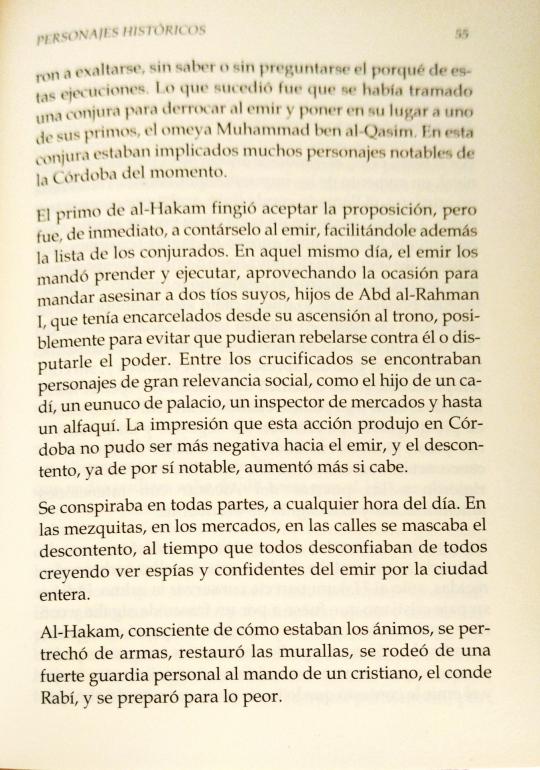
gan to exalt, without knowing or without asking themselves the reason for these executions. What happened was that a plot had been hatched to overthrow the emir and put in his place one of his cousins, the Umayyad Muhammad ben al-Qasim. Many notable people from the Córdoba of that time were involved in this conspiracy. Al-Hakam's cousin pretended to accept the proposal, but was immediately to tell the emir, also providing him with the list of the conspirators. Inthat same day, the emir ordered them to be arrested and executed, taking advantage of the occasion to order the murder of two of his uncles, sons of Abd al-Rahman I, who had been imprisoned since his ascension to the throne, possibly to prevent them from rebelling against him or challenging him for power. Between the crucified were figures of great social relevance, such as the son of a cadi, a palace eunuch, a market inspector and even a alfaqui. The impression that this action produced in Córdoba could not be more negative towards the emir, and the discontent, already notable, increased.
There was a plotting everywhere, at any time of the day. In the mosques, in the markets, in the streets discontent was chewed, while everyone distrusted everyone, believing they saw spies and confidants of the emir throughout the entire city.
Al-Hakam, aware of the mood, equipped himself withweapons, restored the walls, surrounded himself with a strong personal guard under the command of a Christian, Count Rabí, and prepared himself for the worst.
#book scans#al andalus. historical figures#al andalus. personajes históricos#al andalus#al andalus history#bookblr#historyblr#spanish history#sulayman ibn yaqzan ibn al-arabi#amrus ibn yusuf#rabadies#rabadi#al hakam i#al hakam i of córdoba#emirate of cordoba#umayyad emirate of córdoba#middle ages#rabadid dinasty#hisham i#hisham i of cordoba
10 notes
·
View notes
Text
First of all, thank you for following the bookscans posts, I hope you're enjoying them. Now I wanted to share some extra facts related to the third part, like the Tudmir Pact and more about Abd al-Aziz and Egilona, so here we go:
• The Tudmir pact
The pact between Teodomiro and Abd al-Aziz was signed on April 5, 713 and its text is:
In the Name of Allah, the Gracious, the Merciful. Edict of 'Abd al-'Aziz ibn Musa ibn Nusair to Tudmir ibn Abdush [Theodomir, son of the Goths]. The latter obtains peace and receives the promise, under the guarantee of God and his prophet, that his situation and that of his people will not be altered; that his subjects will not be killed, nor taken prisoners, nor separated from their wives and children; that they will not be prevented from practicing their religion, and that their churches will not be burned or deprived of the objects of worship that are in them; all this as long as it satisfies the obligations we impose on it. Peace is granted with the delivery of the following cities: Uryula [Orihuela], Baltana, Laqant [Alacant], Mula, Villena, Lurqa [Lorca] and Ello. Furthermore, you must not give refuge to anyone who flees from us or is our enemy; nor cause harm to anyone who flees from us or is our enemy; nor cause harm to anyone who enjoys our amnesty; nor hide any information about our enemies that may come to their knowledge. He and his subjects will pay an annual tribute, each person, of one dinar in cash, four measures of wheat, barley, grape juice and vinegar, two of honey and two of olive oil; for the servants, only a measure. Given in the month of Rajab, year 94 of the Hegira [713]. As witnesses, 'Uthman ibn Abi 'Abda, Habib ibn Abi 'Ubaida, Idris ibn Maisara and Abu l-Qasim al-Mazali.
Various versions of the Pact of Tudmīr are known, all of them are not contemporary and it seems that the pact had an important impact, since there are manuscripts about It writen by some authors throughout the Middle Ages, the oldest by geographer Abu al-Abbás Áhmad ibn Úmar al-Uḏrī (Dalías, Almería, 1003- Almería or Valencia, 1085), those by Abū Ja'far Aḥmad ibn Yaḥyā ibn Aḥmad ibn 'Amirah al-Ḍabbī (Vélez-Rubio or Vélez-Blanco, Almería, 1155/1156- Murcia, 1203), Abu Hamid al-Garnāṭī (Granada, 1256-Cairo, 1344) and Ibn Abd-al-Múnim al-Ḥimyarī (Ceuta, 15th century- ?, 1495).
At the library of the Royal Monastery of San Lorenzo de El Escorial is preserved the manuscript of the al-Ḍabbī version of the pact (well, plus some annotations in Spanish from early 19th century) in his work Bughyat al-multamis fī tārīkh rijāl ahl al-Andalus (Wish fulfilled of the one who investigates, about the history of the men of al-Andalus), which is part of the Arabic manuscripts collection held at El Escorial (in the web you can find 153 digitalized manuscripts), started by Phillip II of Spain during the 16th century.
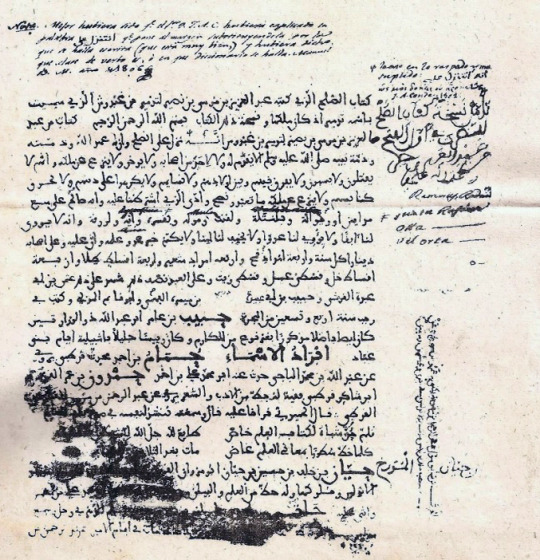
Btw this Arabic manuscript collection is the topic of one of the chapters of the book De Mayrit a Madrid (From Mayrit to Madrid), one of the books that is on the bookscans list, so if you want to know more about this topic, wait for when I share its bookscans.
And for ending with the Tudmir Pact, here's a map showing the cities included in the pact:

• Abd al-Aziz and Egilona
Note: The genealogical links listed below might not be 100% exact, because some data varies depending on the source. Sorry if it's a bit messy, genealogy is complicated (specially if Royal families are involved)
An interesting fact is that some sources point that Abd al-Aziz's mother was Umm bint Marwan ibn al-Hakam, a daughter of Caliph Marwan I, making Abd al-Aziz (born in 685) one of the grandsons of the 4th Umayyad Caliph of Damascus.
During the conquest, Abd al-Aziz and Egilona married in 713. Due to the name Umm'Asim Egilona is sometimes given, it's known that they had a son, although it's not known anything more about him, and they had a daughter too, Aïsha.

After the death of Musa ibn Nusayr in 715, Abd al-Aziz started to mistrust the new Caliph Suleyman, as its possible that the Caliph ordered to murder Musa.
The relationship between the Caliph and Abd al-Aziz was tense, since Abd al-Aziz's title of governor of Al Andalus was given by his father Musa ibn Nusayr, not by the Caliph, so Sulayman was afraid of a possible uprising and Abd al-Aziz turning Al Andalus into an independent territory. As it is possible that Egilona suggested Abd al-Aziz to crown himself and turn away from the caliphate, or at least that were the rumours, and that alleged conspiracy led to Sulayman sending Ziyad ibn Udhara to murder Abd al-Aziz in Seville in 716.
It is not known exactly when Egilona died, although is likely the year of her death is after 718. About their daughter Aïsha bint Abd al-Aziz, she eventually married Fortún ibn Qasi, governor of Zaragoza and the Ebro valley and head of the Banu Qasi, and had two sons Zahir and Musa ibn Fortun, the later married Oneka of Pamplona. They had two sons, Mutarrif and Musa ibn Musa, whom later in the book AL ANDALUS. Historical figures there will be a chapter about (the chapter Musa ben Musa ben Qasi, the third King of Spain). Musa ibn Musa's domains were occasionally independent from the Umayyad emirate of Córdoba since he and his descendants allied with either the emirate or with Christians like the future kingdom of Navarre, whose Royal family had blood ties with the Banu Qasi, some of them being:
- Eneko Aritza, Lord "King" of Pamplona, was Musa ibn Musa's brother, since Eneko was the son Oneka had with her first husband Eneko Semenoitz
- Asona Enekoitz, one of the daughters of Eneko Aritza, niece and wife of Musa ibn Musa. Their children were Lubb ibn Musa, Mutarrif ibn Musa, Fortún ibn Musa and Awriya bint Musa
- Belasquita Garcés of Pamplona, daughter of Eneko Aritza's son, García. She was Musa ibn Musa's daughter-in-law since he married Mutarrif ibn Musa ibn Musa.
- Fortún Garcés, son of Eneko Aritza's son García. Fortun married Awriya bint Lubb ibn Musa, daughter of Lubb ibn Musa and an Arab noblewoman Ayab al-Bilatiyya. Their children were Eneko, Aznar, Belasko, Lope and Oneka.
- Oneka Fortúnez, daughter of Fortún Garcés and Auria/Awriya bint Lubb. Oneka Fortúnez married twice, she firstly wed the Emir Abd Allah I of Córdoba, she was known as Durr (Pearl), their children being Muhammad, Zayd, al-Baha' and Fatima, Muhammad's son was the first Caliph of Córdoba, Abd al-Rahman III; then Oneka married her cousin Aznar Sánchez.
Descendants by MUHAMMAD
- Muhammad, son of Emir Abd Allah I of Córdoba and Oneka Fortúnez, he had Abd al-Rahman III with a Basque woman, Muzna.
- Abd al-Rahman III, 8th Emir and first Caliph of Córdoba. He had several wifes and concubines, and many children, but the one who succeeded him was al-Hakam II, one of the sons he had with one of his wifes, a Christian captive called Maryam.
- Al-Hakam II, 2nd Caliph of Córdoba, son of Abd al-Rahman III and Maryam. Al-Hakam was succeeded by Hisham II, a son he had with the concubine, Subh al-baskunsiyya, a Basque woman named Aurora, but then she took the name Subh.
- Hisham II, 3th Caliph of Córdoba, son of al-Hakam II of Córdoba and Subh. He firstly was overthrown by Muhammad II, and became Caliph again after the second rule of Muhammad ended.
-Muhammad II, 4th Caliph of Córdoba, son of Hisham, who was son of Abd al-Yabbar, one of Abd al-Rahman III's sons. He overthrew Hisham II, but Muhammad II was overthrown by Suleyman al-Mustaín, and Muhammad II started his second rule after he overthrew Suleyman. Muhammad II's sons were Abd al-Rahman IV and Hisham III.
- Suleyman, 5th Caliph of Córdoba, son al- Hakam, who was son of Suleyman, one of Abd al-Rahman III's sons. After Hisham II died, Suleyman's second rule started, but he was defeated and killed by the governor of Ceuta, Alí ibn Hamud al-Násir, who became the 6th Caliph of Córdoba and first Caliph of the Banu Hamud dinasty.
- Abd al-Rahman IV, 7th Caliph of Córdoba, son of Muhammad II. After Ali ibn Hamud was murdered, he was proclaimed Caliph, although it was después with Ali ibn Hamud's brother Al-Qásim, and after Abd al-Rahman IV died, Al-Qásim fully became the 8th Caliph of Córdoba.
- Abd al-Rahman V, 10th Caliph of Córdoba, brother of Muhammad II. After the second rule of Al-Cásim ended, he became Caliph, but he was murdered a year later. He was succeeded by his cousin Muhammad III.
- Muhammad III, 11th Caliph of Córdoba, son of Abd al-Rahman, who was son of Ubayd Al-lah, one of Abd al-Rahman III's sons. He had a daughter with the slave Amin'am, who was Wallada bint al-Mustakfi. Muhammad died, and Ali ibn Hamud's son, Yahya al-Muhtal returned.
- Hisham III, 12th Caliph of Córdoba, son of Muhammad II. He became Caliph when Yahya al-Muhtal was overthrown and his second rule ended. After some years, Hisham III was overthrown during a popular uprising, the Caliphate of Córdoba was abolished, so Hisham was the last Caliph of Córdoba, and the first period of Taifas began.
- Wallada bint al-Mustafki, the only child of Muhammad III, became a famous poetress. Wallada inherited her father's assets when he died and she opened her palace to the education of women from good families to women of low status and even slaves; poets and writers also attended. Among her students, Muhya bint al-Tayyani stands out, a poetress of very humble status. Wallada welcomed her into her palace, and it is said that they were lovers.
It is known that she embroidered her verses on her dresses, being the most well-known: "By Allah, I deserve any greatness/ and I proudly continue my path/ I gladly give my lover my cheek / and I give my kisses to whoever wants them"; and she did not veil on the street. Wallada participate in men's competitions, in one of them she met the poet Ibn Zaydún, with whom she had a passionate love story, as is it shown in several of their poems. Wallada had other lovers like Ibn Abdus, but she never married.
(Mental Note: I have to dedicate a post to Wallada's poetry someday)
Descendants by AZNÁR SANCHEZ
- Toda Aznárez, daughter of Oneka Fortúnez with her second husband Aznar Sánchez. Toda married Sancho I of Pamplona, a distant cousin and first official King of Pamplona. Their children were García I of Pamplona (married Countess Andregoto I of Aragon, their son was Sancho II of Pamplona), Urraca (married Ramiro II of Leon), Oneka (married Alfonso IV of León, their son was Ordoño IV), Sancha (married Ordoño II of León, their son was Sancho I) , Belasquita and Orbita (married al-Tawil, governor of Huesca).
- Sancho II of Pamplona, García I and Andregoto's son, married Urraca Fernández, daughter of Fernán González, Count of Castile. Among their children were García II of Pamplona and Urraca. Urraca married Al-Mansur, hayib of Caliph Hisham II of Córdoba, and she took the name Abda, and was the mother of Abd al-Rahman Sanŷul (or Sanchuelo), who became hayib of Hisham II after his brother ʿAbd al-Málik al-Muẓáffar (son of Al-Mansur and Al-Dalfāʾ) died. Abd al-Rahman Sanchuelo had a son, Abd al-Aziz ibn Ámir, who, after the of the Caliphate was splitted into Taifas, became Emir of the Taifa of Valencia. Abd al-Aziz was succeeded by his son Abd-al-Malik, but Abd-al-Malik was overthrown by Al-Mamún, Emir of the Taifa of Toledo.
- García II of Pamplona was succeeded by his son Sancho II of Pamplona, who married Muniadona of Castile, and they were parents of García III of Pamplona (ancestors of the Kingdom of Navarre) and Ferdinand I of Leon, who married Sancha of Leon, who was the great-great-grandaughter of Ramiro II of Leon (ancestors of the Crown of Castile and the Kingdom of Portugal, via their son Alfonso VI of Leon). Plus Sancho II of Pamplona had a son out of wedlock, Ramiro I of Aragon (ancestors of the Crown of Aragon)
#al andalus#historyblr#pact of tudmir#al andalus. historical figures#al andalus. personajes históricos#abd al-aziz ibn musa#abd al-aziz#teodomiro#tudmir#spanish history#al andalus history#book scans related#book scans#bookblr#egilona#ailo#queen egilona#umm'asim
6 notes
·
View notes
Text
Third part of the bookscans of Al Andalus. Historical Figures, here's the previous part
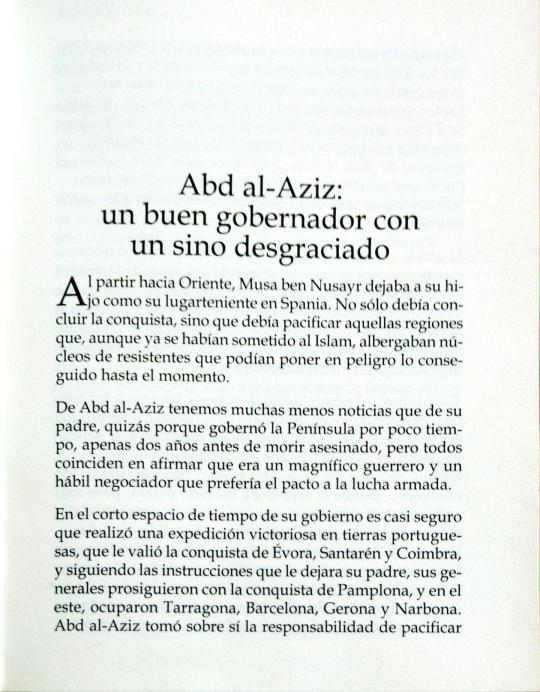
Abd al-Aziz: a good governor with an unfortunate fate
When leaving for the East, Musa ben Nusayr left his son as his liutenant in Spania. Not only he had to conclude the conquest, but had to pacify those regions that, although they had already submitted to Islam, housed groups of resisters who could put in danger what has been achieved so far.
We have much less news about Abd al-Aziz than about his father, perhaps because he ruled the Peninsula for a short time, just two years before being murdered, but they all agree that he was a magnificent warrior and a skilled negotiator who preferred pact to armed struggle.
In the short period of time of his government it is almost certain that he carried out a victorious expedition in Portuguese lands, which earned him the conquest of Évora, Santarém and Coimbra, and following the instructions that his father left him, his generals continued with the conquest of Pamplona, and in the east, they occupied Tarragona, Barcelona, Girona and Narbonne. Abd al-Aziz took upon himself the responsibility of pacifying

some rebellious areas of eastern Andalusia and the Levant. He owes himself the conquest of Málaga and Elvira and the advance on lands of Murcia, at that time in the hands of a Visigoth nobleman, Teodomiro, vassal of the kingdom of Toledo, who ruled the region as a practically independent prince. And here we can see the negotiating spirit of Abd al-Aziz, who knew take good advantage of the pact he established with Teodomiro, Tudmir in Arabic, and the name by which it will henceforth be known the Murcian region.
The Christian count and the Muslim governor engaged conversations in which the second offered the first the maintenance of all his prerogatives, as count and as Christian, as well as total respect for his subjects, in exchange for the recognition of vassalage, the payment of an annual tribute and the delivery of seven strongholds, a delivery that would be carried out immediately.
Teodomiro, or Tudmir, must have weighed the pros and cons. The Christian kingdom of Toledo no longer existed, and it made no difference to be a vassal of the Goths as well as the Muslims. Without a doubt, too paid tributes to Rodrigo's monarchy and those that now Abd al-Aziz imposed were not too onerous... There was the matter of the seven strogholds, but it was better to give in on something that lose everything. The document signed between Teodomiro and the Muslim leader, one of the few treatises of this type that have come down to us, and it specifies that everyone, the count and his vassals, will preserve their religion and their churches, will maintain their rights of sovereignty and will not be bothered at any time, neither in their lives, nor in their estates,

as long as they comply with what is stipulated. And what was stipulated was the delivery of Orihuela, Baltana, Alacant, Mula, Villena, Lorca and Ello. The annual tribute consisted of one dinar in cash, four bushels of wheat and four of barley, four measures of new wine, four of vinegar, two of honey and two of oil. This tax was reduced by half for the slaves.
If we have detailed the characteristics of this treaty, it is because of its rarity. and because, according to Levy Provençal, it is the first document diplomat of Muslim Spain.
Abd al-Aziz married the widow of King Don Rodrigo, at least that is what several historians say. It seems that they met after the fall of Mérida, when the royal widow left the city with another group of captives. Some consider this wedding as a real love story, at least on the part of Abd al-Aziz, since it seems that he did not take another wife. The Arab chroniclers call her Ailo and the Christians Egilona. Some say that her husband allowed her to keep her religion, gesture that was very well received among the Mozarabs, and others say that converted to Islam and was renamed Umm'Asim, “the mother of Asim", as soon as the only son she had with Abd al-Aziz was born.
The couple lived almost always in Seville, where it is still preserved, in the gardens of the Alcázar, a white tower of typical African construction, known as "the Tower of Abd al-Aziz". However, if they were happy, their happiness must have lasted little, because at the same time Seville, an envoy of the Caliph Sulayman, Ziyad ben Udhara, assassinated him in the church of Santa Rufina, converted into a mosque, while Abd al-

Aziz performed the pious duties of prayer. The charge against him, according to the caliph, was abuse of power. He was beheaded and his head was sent to Damascus.
A confusing time passed in Muslim Spain that was left without a governor. The Spanish Arabs decided that the son of a sister of Musa ben Nusayr would occupy the position until the one appointed by the caliph arrived.

The oddyssey of Prince Abd al-Rahman the Immigrant
After the violent death of Abd al-Aziz, the governors of the Muslims succeeded one another in Spain at an astonishing speed. Some barely held office for six months and It seems that only one of them lasted for about five years. They were difficult times in Muslim Spain. Had have deepen the conquest, quell the possible rebellions that could arise among groups of defeated and, also, and not less important was to make peace between the different Muslim factions, without dismissing the possibility of carrying out raids over lands of Gaul.
In the East, in turn, there was a complicated situation, such as result of the dissent of various religious groups that put the unity of Islam is endangered. Jarichis and Shiites conspired, already openly, against the Umayyad dynasty that reigned in those moments, without the caliphs having the strength or intelligence enough to face that situation that, each time, became more dangerous for them.

The flag of rebellion against the Umayyads was raised everywhere in the Muslim empire, awaiting the arrival of the "imam hidden" that was going to restore to Islam all the purity of its faith and all the splendor of its early days. The black flags, symbol of a new dynasty, the Abasid, were already flying in the Furasan and in the large Iraqi city of Cuta. Abu-l-Abbas Abd Allah proclaimed himself caliph, as a descendant of a first cousin of Muhammad and his son-in-law Ali. According to him, he was the imam that everyone expected and fought Marwan II, the last Umayyad caliph who would die with weapons in hand on July 7, 750.
The new Abbasid caliph, even before the death of Marwan, had already began the extermination of all the Umayyad princes who were left. They were persecuted to death, without mercy, and their bodies, as the maximum punishment, were left unburied. And for what no one would escape from that carnage that would cost its executioner the nickname "the bloodshed", resorted to a cruel stratagem. He proclaimed a false amnesty in which they trusted the relatives of the last caliph, which allowed, in one fell swoop, end the lives of about eighty people belonging to the Umayyad royal family, at Abu Futrus, near Jaffa, Palestine.
Only two Umayyads, grandsons of Caliph Abd al-Malik ben Marwan, distrusting the amnesty proclaimed by their enemy, managed escape from that horrible massacre. It was about the brothers Yahya ben Muawiya and Abd al-Rahman.
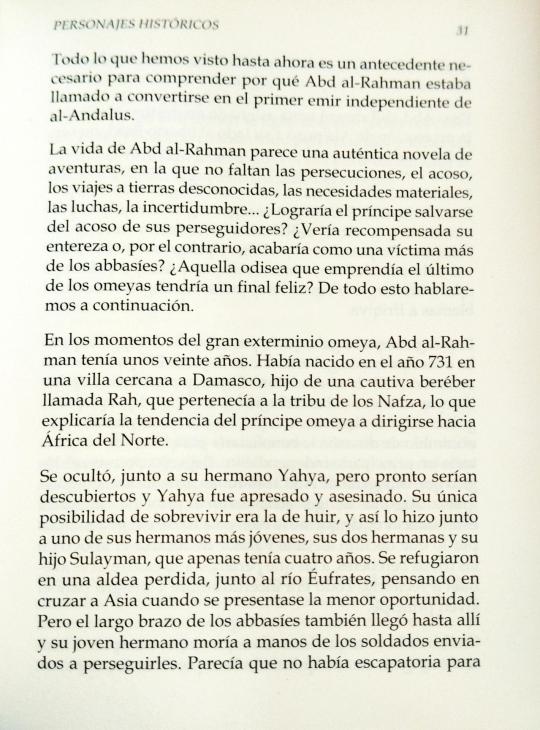
Everything we have seen so far is a necessary background to understand why Abd al-Rahman was called to become the first independent emir of al-Andalus.
The life of Abd al-Rahman seems like a real adventure novel, in which there is no shortage of persecutions, harassment, trips to unknown lands, the material needs, the struggles, the uncertainty...The prince would manage to save himself from the harassment of his pursuers? He would see his integrity rewarded or, on the contrary, would he end up as another victim of the Abbasids? That odyssey that would the last of the Umayyads undertake have a happy ending? From all of this We will talk next.
At the time of the great Umayyad extermination, Abd al-Rah-man had about twenty years. He was born in the year 731 in a town near Damascus, son of a Berber captive named Rah, who belonged to the Nafza tribe, which would explain the tendency of the Umayyad prince to head towards North Africa.
He hid, along with his brother Yahya, but they would soon be discovered and Yahya was captured and killed. His only chance to survive was to flee, and so he did with one of his younger brothers, his two sisters and his son Sulayman, who was barely four years old. They took refuge in a lost village, next to the Euphrates River, thinking about cross to Asia when the slightest opportunity presented itself. But the long arm of the Abbasids also reached there and his young brother died at the hands of the soldiers sent to pursue them. It seemed that there was no escape for

the Umayyad prince, when he saved himself by swimming across the Euphrates River.
But Abd al-Rahman was assigned a glorious destiny and protection of Allah he placed at his side the freedman Bard, a servant and counselor, who will accompany him throughout his life, even in the most difficult and who will maintain unlimited loyalty towards his lord, so unfortunate at that time. Bard managed to collect some wealth belonging to Abd al-Rahman and join him in Palestine. They undertook a long and dangerous journey across the Isthmus of Suez, trying to go unnoticed and rushing long and exhausting days, they arrived without problems at Ifriqiya.
This region was ruled by a Fhirid Arab who aspired to be appointed governor of Spain. He was a close relative of the Walí of al-Andalus. Some supporters of the Umayyads were refugees in Ifriqiya and, although the governor said he was opposed to the Abbasids, he thought that the change of dynasty would benefit him to make his territory an independent principality. Under this premise it is logical that Abd al-Rahman's arrival did not please him at all. Some friends warned the Umayyad prince of this situation and it was better not to trust the governor, so he decided to move away and try to enlist the support of the Berber tribes, to which his mother belonged, if they agreed to receive him. Everything was uncertainty and danger for the young prince.
Four years passed on these trips, always in search of support, of tranquility, of survival, while
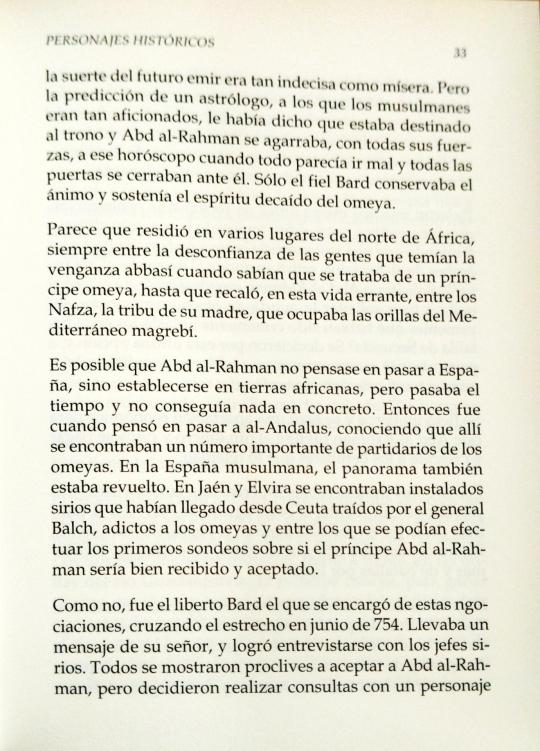
The fate of the future emnir was as indecisive as it was miserable. But the prediction of an astrologer, to whom the Muslims were so fans, had told him that he was destined for the throne and Abd al-Rahman clung, with all his strength, to that horoscope when everything seemed to be going wrong and all the doors were closing before him. Only the faithful Bard kept his spirits and sustained the fallen spirit of the Umayyad.
It seems that he lived in various places in North Africa, always between the distrust of the people who feared Abbasid revenge when they knew that he was an Umayyad prince, until he landed, in this wandering life, among the Nafza, his mother's tribe, who occupied the shores of the Mediterranean Maghreb.
It is possible that Abd al-Rahman did not think of going to Spain, but settle in African lands, but time passed and no achieved nothing in particular. That's when he thought about moving on to al-Andalus, knowing that there were a important number of supporters of the Umayyads. In Muslim Spain, the panorama was also mixed. In Jaén and Elvira they were installed Syrians who had arrived from Ceuta brought by the general Balch, addicted to the Umayyads and among whom the first polls on whether Prince Abd al-Rahman would be good received and accepted.
Of course, it was the freedman Bard who was in charge of these negotiations, crossing the strait in June 754. He carried a message from his lord, and managed to meet with the Syrian leaders. Everyone was willing to accept Abd al-Rahman, but decided to consult with a very important person

which was the most considered in al-Andalus. It was about the Qaysi chief, al-Sumayl, at that time governor of Zaragoza, who was defending the stroghold from the Berber siege and Kalbi Arabs. Once this coalition was defeated, al-Sumayl listened to the proposals of Bard and his companions and took his time to think about it.
Many months passed before receiving a reply, which was positive, but in the end, fearing the Abbasid reaction or fearing that an Umayyad restoration would take away freedom from the Arabs of al-Andalus, he withdrew his support for the project. What to do? Request Abd al-Rahman to desist from setting foot in Spain or request help from other groups such as the Yemenis who had been cruelly crushed in the battle of Secunda? They decided for this last option and, from this moment, with his help, the panorama was cleared for the Umayyad prince.
A boat was chartered and a financial contribution was made so that Abd al-Rahman had some money and could pay his ransom to the Berbers who held him.
Finally, after countless waits, after long trips, after untold deprivations, August 14, 755, Abd al-Rahman set foot on Hispanic soil in the port of Almuñécar. Now a new stage began, not exempt from problems and battles to fight.
The governor of al-Andalus was, at that time, Yusuf al-Fihrí, busy suppressing a rebellion by the Basques. He decided go to Córdoba leaving his son in charge of Zaragoza and the defense of Pamplona. However, he soon learned of defeat of his hosts and the arrival of the Uma-
#al andalus#al andalus history#al andalus. personajes históricos#al andalus. historical figures#book scans#bookblr#historyblr#abd al-aziz ibn musa#abd al rahman i#abd al rahman i of córdoba#abd al rahman i de córdoba#egilona#queen egilona#ailo#abd al-aziz#sorry for the cliffhanger
8 notes
·
View notes
Text
Also related with the second part of the bookscans, I would like to add some pictures of the first gold dinars of Al Andalus, the transitional coins during the conquest of the Iberian Peninsula. They are from the years 712/713 (94 of Hegira) and 716/717 (98 of Hegira), the first ones have Latin characters, but the last ones are bilingual, and are in both Arabic and Latin:

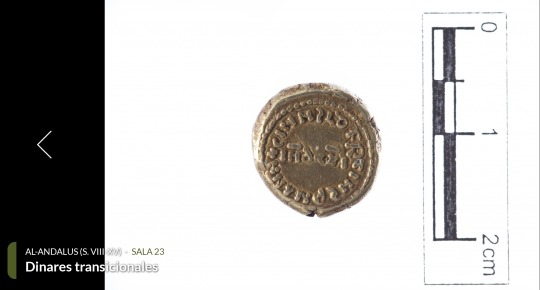
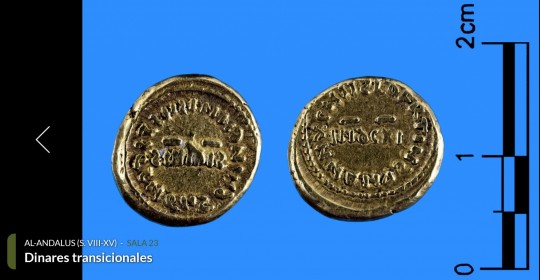
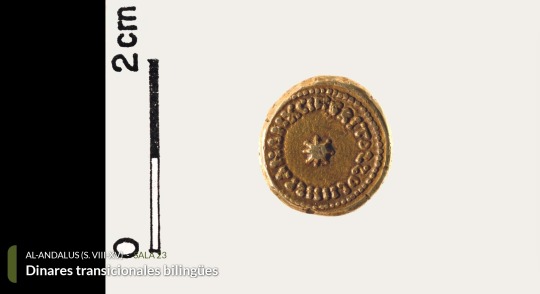
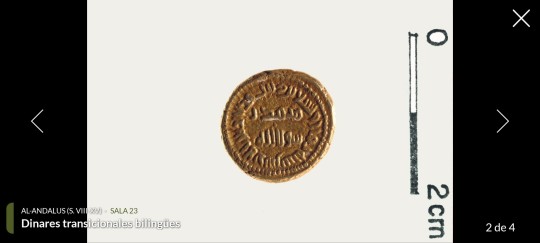
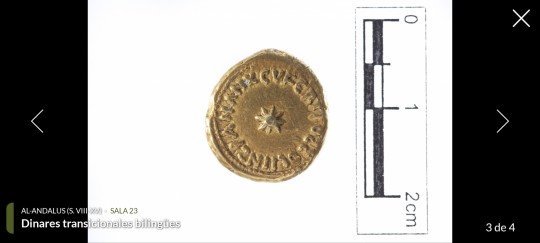
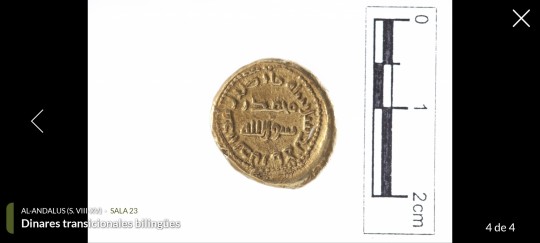
These are from the Al-Andalus' section of the Spanish National Archaeological Museum, concretely I got the pictures from the museum's free app (the app is mainly a virtual tour inside the museum that offers a close-up of the exhibits)
Bonus track: A map of the conquest
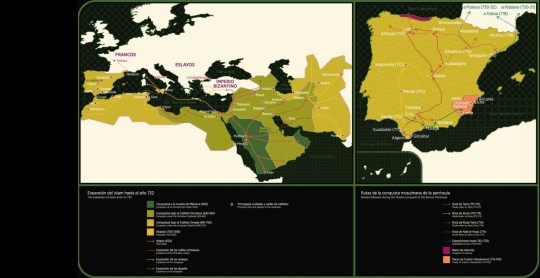
#al andalus#book scans#al andalus history#al andalus. historical figures#al andalus personajes históricos#historyblr#bookscans related#spanish history#coins#dinar#8th century#arqueology
11 notes
·
View notes
Text
Second part of the bookscans of Al Andalus. Historical Figures, here's the previous part
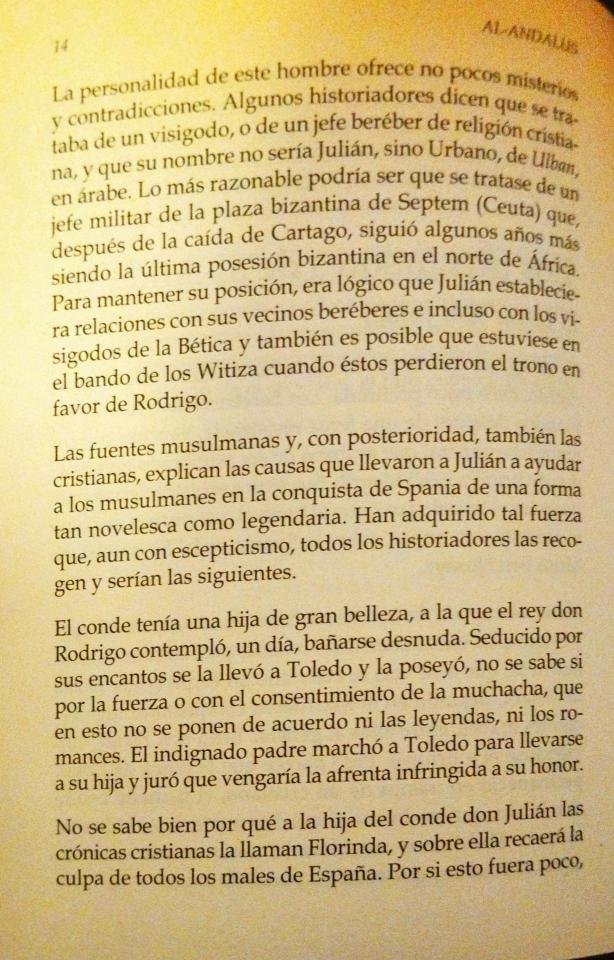
The personality of this man offers many mysteries and contradictions. Some historians say that he was a Visigoth, or a Berber of Christian religion, and that his name would not be Julián, but Urban, from Ulban, in Arabic. The most reasonable thing could be that he is a military commander from the Byzantine square of Septem (Ceuta) which, after the fall of Carthage, continued to be the last Byzantine position in North Africa for a few more years. To maintain his position, it was logical that Julián established relations with his Berber neighbors and even the Visigoths of Baetica and it is also possible that he was on the side of the Witizas when they lost the throne in favor of Rodrigo.
The Muslim sources and, later, also the Christians, explain the causes that led Julián to help the Muslims in the conquest of Spania in such a way novel as well as legendary. They have acquired such strength that, even with skepticism, all historians collect them and they would be the following. The count had a daughter of great beauty, whom the king Rodrigo, one day, contemplated her bathing naked. Seduced by her charms he took her to Toledo and possessed her, it is not known if because of force or with the consent of the girl, who in this neither legends nor romances agree. The indignant father marched to Toledo to take his daughter and swore that he would avenge the affront inflicted on her honor. It is not well known why the daughter of Count Don Julián is called Florinda in Christian chronicles, and on her will fall the blame for all the ills of Spain. As if this were not enough,

the name will be completed with “la Cava”, a word of Arabic origin which translates to "prostitute".
Upon returning to Africa, the hurt count went to Ifriqiya to see Musa ben Nusayr, and put before his eyes the ease with which one could conquer Spania and the great advantages that would be obtained from it. The Muslim governor willingly accepted the offer and suggested that it would be Count Don Julián himself who carried out an incursion onHispanic lands. With a small army, Julian landed in the bay of Algeciras and in a daring raid, he returned to Ceuta with good loot and numerous captives. It would be approximately October or November of the year 709.
Musa began to consider the possibility of an expedition against Spania, but for this he needed the permission of the Caliph of Damascus. In addition, there was another problem: crossing the Strait of Gibraltar. The Muslims did not have ships and distrusted the marine environment that they considered a bit strange, but Count Don Julián would come to solve this problem. The Caliph of the East, for his part, continued to maintain his reservations about this operation that would ultimately be carried out, perhaps because the insistence of their North African governors.
Tarif ben Malluk
Finally, the first Muslim landing occurred in July 710. There were about four hundred men under the command of a Berber officer, Tarif ben Malluk, the first Muslim to set foot in Spania. His name would last, forever, in the
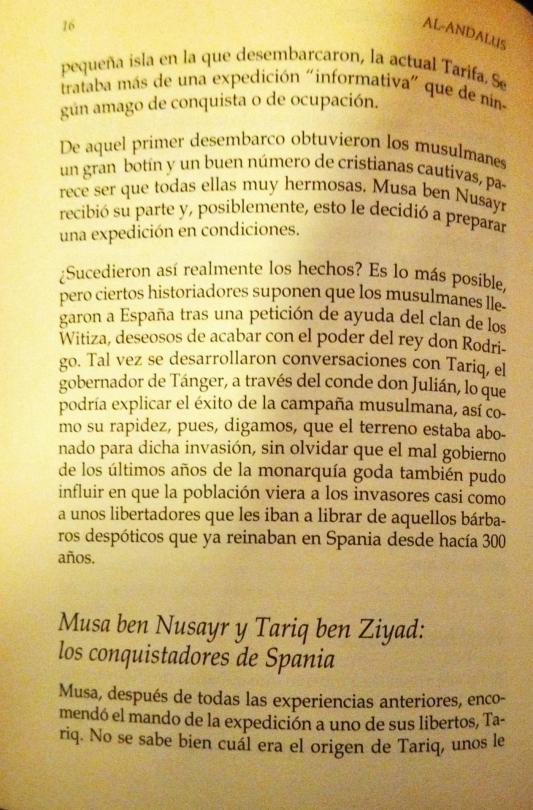
small island where they landed, the current Tarifa. It was more of an “informative” expedition than a threat of conquest or occupation. From that first landing the Muslims obtained Muslims obtained a great booty and a good number of captive Christian women, it seems to be that all of them are very beautiful. Musa ben Nusayr received his part and, possibly, this decided him to prepare a proper expedition. Did the events really happen like this? It is the most possible, butcertain historians suppose that the Muslims came to Spania after a request for help from the Witiza clan, eager to put an end to the power of King Don Rodrigo. Maybe conversations took place with Tariq, the governor of Tangier, through Count Don Julián, which could explain the success of the Muslim campaign, as well as its speed, therefore, let's say that the ground was fertile for said invasion, without forgetting that the bad government of the last years of the Gothic monarchy could also influence the population to see the invaders almost as if they were liberators who were going to rid of those despotic barbarians who already reigned in Spania for 300 years.
Musa ben Nusayr and Tariq ben Ziyad: the conquerors of Spania
Musa, after all the previous experiences, entrusted the command of the expedition to one of his freedmen, Tariq. It is not well known what Tariq's origin was, some
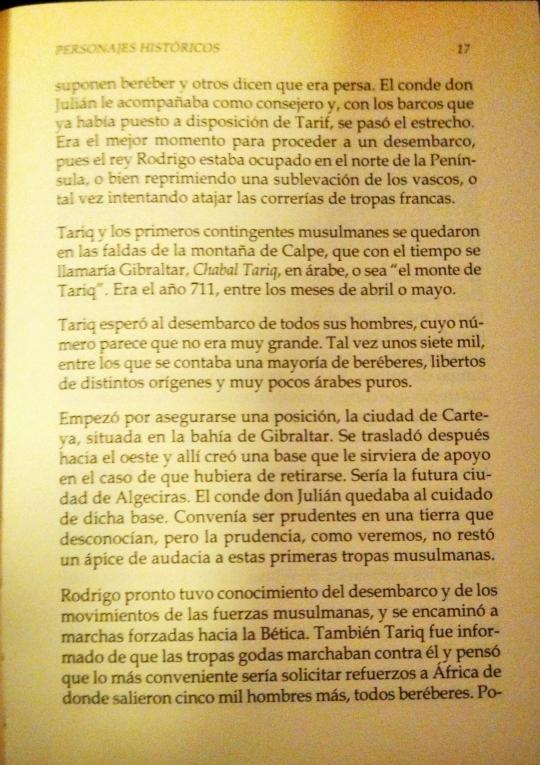
assume he was Berber and others say he was Persian. Count Don Julián accompanied him as a counselor and, with the ships that he had already put to Tarif's disposition, the strait was crossed. It was the best time to proceed to landing, since King Rodrigo was busy in the north of the Peninsula, or repressing an uprising of the Basques, or perhaps trying to stop the raids of Frankish troops.
Tariq and the first Muslim contingents stayed in the foothills of the Calpe mountain, which in time would be called Gibraltar, Chabal Tariq, in Arabic, that is, “the mountain of Tariq.” It was the year 711, between the months of April or May.
Tariq waited for all his men to disembark, whose number seems like it wasn't very big. Perhaps seven thousand, among whom the majority were Berbers, freedmen of different origins and very few pure Arabs.
He began by securing a position, the city of Carteya, located in the bay of Gibraltar. He then moved west and there created a base that would serve as support in the event that it had to backing out. It would be the future city of Algeciras. Count Don Julián was in the care of said base. It was advisable to be cautious in a land that they did not know, but prudence, as we will see, did not took less audacity to these first Muslim troops.
Rodrigo soon learned of the landing and the movements of the Muslim forces, and set out on marches forced towards Baetica. Tariq was also informed that the Gothic troops were marching against him and he thought that the most convenient would be to request reinforcements from Africa where five thousand men came from more, all Berbers. Po-
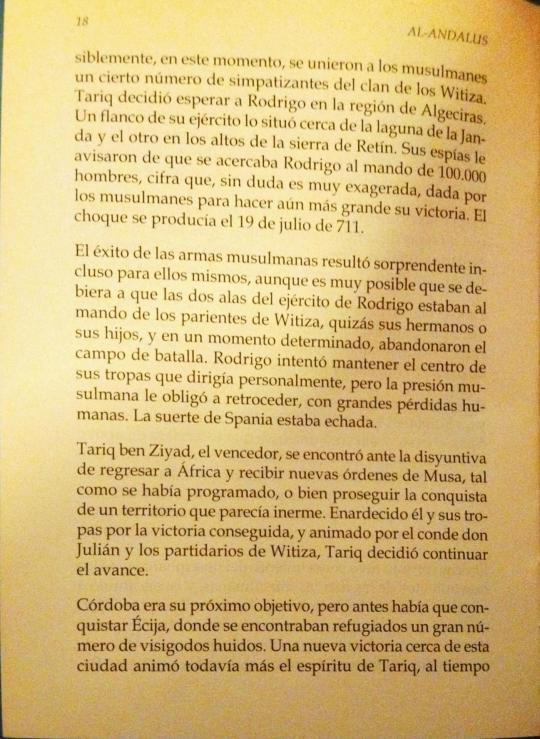
ssibly, at this time, the Muslims were joined by a certain number of sympathizers of the Witiza clan. Tariq decided wait for Rodrigo in the region of Algeciras. One flank of his army was placed near the Janda lagoon and the other on the heights of the Retín mountain range. His spies warned him that Rodrigo was approaching commanding 100,000 men, a figure that is undoubtedly very exaggerated, given by the Muslims to make even bigger their victory. The clash occurred on July 19, 711.
The success of Muslim weapons was surprising even for themselves, although it is very possible that it was because the two wings of Rodrigo's army were commanded by the relatives of Witiza, perhaps his brothers or his children, and in a certain moment, they left the battlefield. Rodrigo tried to hold the center of his troops that he led personally, but Muslim pressure forced him to retreat, with great human losses. Spania's luck was cast.
Tariq ben Ziyad, the victor, found himself faced with the dilemma of returning to Africa and receiving new orders from Musa, as had been scheduled, or continuing the conquest of a territory that seemed defenseless. He and his troops were enraged by the victory achieved, and encouraged by Count Don Julián and Witiza's supporters, Tariq decided to continue the advance. Córdoba was their next objective, but first they had to conquer Écija, where a large number of escaped Visigoths were taking refuge. A new victory near this city encouraged Tariq's spirit even more, while
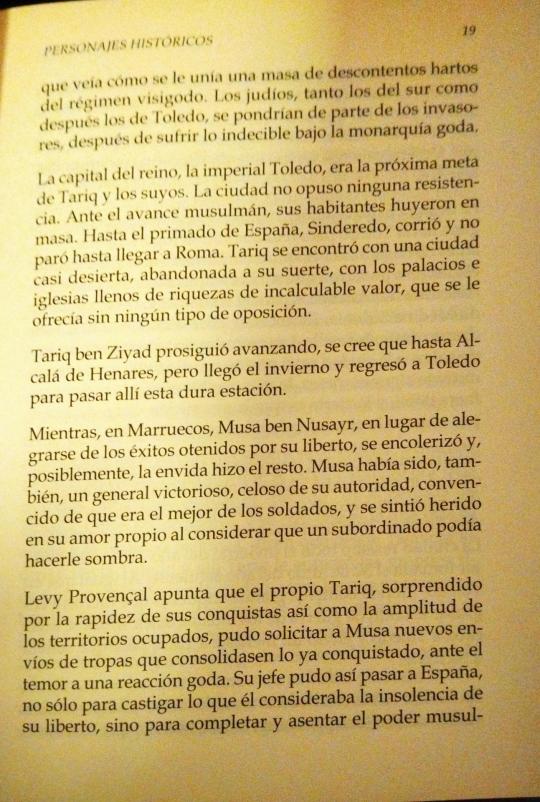
he saw how he was joined by a mass of dissatisfied people fed up with the Visigothic regime. The Jews, both those of the south and later those of Toledo, would side with the invaders, after suffering the unspeakable under the Gothic monarchy.
The capital of the kingdom, the imperial Toledo, was the next goal of Tariq and his people. The city did not put up any resistance. Faced with the Muslim advance, its inhabitants fled. Even the primate of Spania, Sinderedo, ran away and did not stop until he reached Rome. Tariq found an almost deserted city, abandoned to its fate, with palaces and churches full of riches of incalculable value, which were offered to him without any type of opposition. Tariq ben Ziyad continued advancing, it is believed as far as Alcalá de Henares, but winter arrived and he returned to Toledo to spend this hard season there.
Meanwhile, in Morocco, Musa ben Nusayr, instead of rejoicing at the successes achieved by his freedman, became angry and, possibly, envy did the rest. Musa had also been a victorious general, jealous of his authority, convinced that he was the best of soldiers, and he felt hurt in his self-esteem when he considered that a subordinate could overshadow him.
Levy Provençal points out that Tariq himself, surprised by the speed of his conquests as well as the breadth of the occupied territories, was able to request new shipments of troops from Musa to consolidate what had already been conquered, fearing a Gothic reaction. His leader was thus able to go to Spania, not only to punish what he considered the insolence of his freedman, but to complete and establish Mus-

lim power on the Peninsula. Now Musa ben Nusayr crossed the Strait of Gibraltar at the head of 18,000 men, almost all Arabs, among whom were many representatives of the new aristocracy formed by the successors of Muhammad. They landed in the area of Algeciras in June of the year 712. Upon arriving in Spania, it would have been logical for Musa to head towards Toledo to meet with his lieutenant, but before reaching him, he wanted to demonstrate that he was still the powerful warrior who had completed and ensured the conquest of Morocco for Islam. He attacked and took control of Medina Sidonia, Carmona and Alcalá de Guadaira, later besieging Seville. The chroniclers do not agree on whether the city fell soon or if the siege continued for a few months; it is most likely that the resistance was weak, and the truth is that the Visigoth garrison ended up evacuating the city, taking refuge in Niebla.
Seville was an important city, taken with relative ease, which decided Musa to attack Mérida, which at that time hosted the main supporters of King Don Rodrigo. But here things were not so simple. The city resisted throughout the winter of 712 and could only be taken on June 30 of the following year. As in Toledo, Mérida contained great riches that added to the war loot of the Muslims. Musa was approaching Toledo and sent a message to Tariq to come out to meet him. An uprising had broken out in Seville and Musa sent his son Abd al-Aziz to suppress it, an opportunity that he took advantage
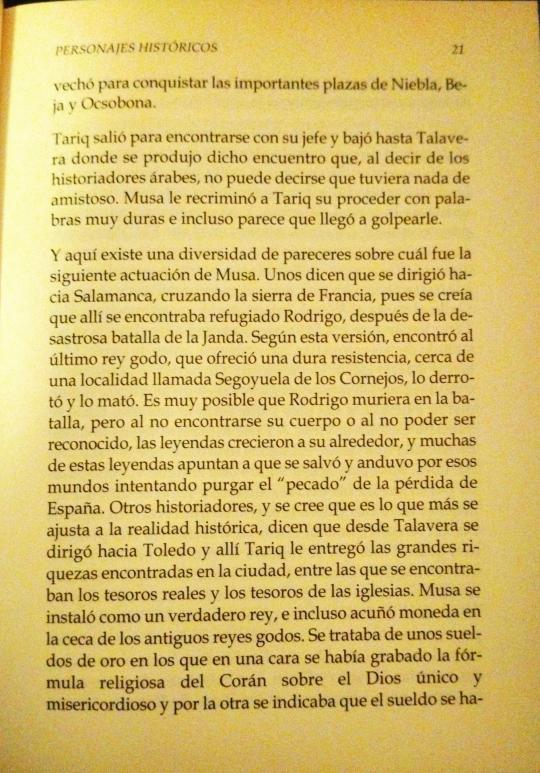
to conquer the important squares of Niebla, Beja and Ocsobona.
Tariq left to meet his boss and went down to Talavera where this meeting took place which, according to Arab historians, cannot be said to have had anything friendly. Musa reproached Tariq for his behavior with very harsh words and it seems that he even hit him.
And here there is a diversity of opinions about what Musa's next performance was. Some say that he headed towards Salamanca, crossing the Sierra de Francia, since it was believed that Rodrigo was taking refuge there after the disastrous battle of La Janda. According to this version, he found the last Gothic king, who offered tough resistance, near a town called Segoyuela de los Cornejos, defeated him and killed him. It is very possible that Rodrigo died in battle, but since his body was not found or could not be recognized, legends grew around him, and many of these legends suggest that he was saved and walked through those worlds trying to purge the “sin” of the loss of Spania. Other historians, and it is believed that this is what most closely corresponds to historical reality, say that from Talavera he headed towards Toledo and there Tariq gave him the great riches found in the city, among which were the treasures royals and the treasures of the churches. Musa installed himself as a true king, and even minted coins in the mint of the ancient Gothic kings. They were golden salaries on which the religious formula of the Koran about the only and merciful God had been engraved on one side and on the other it indicated that the salary had been
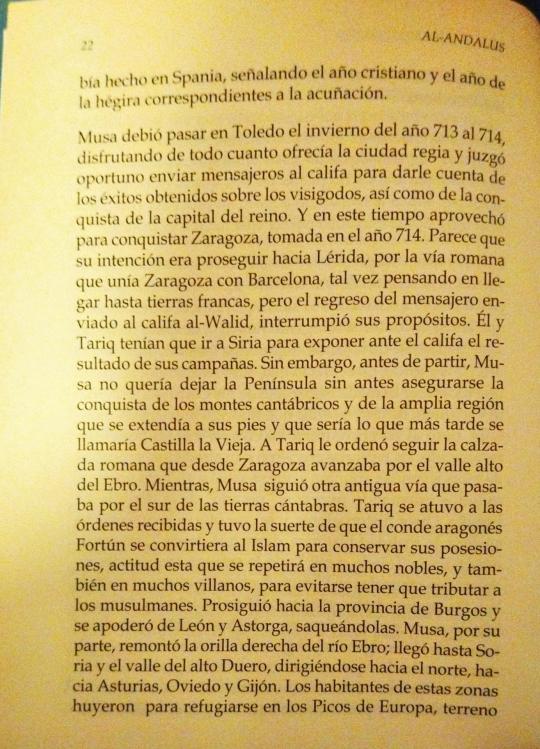
made in Spania, indicating the Christian year and the year of the hegira corresponding to the coinage.
Musa had to spend the winter from 713 to 714 in Toledo, enjoying everything that the royal city offered and considered it appropriate to send messengers to the caliph to inform him of the successes obtained against the Visigoths, as well as the conquest of the capital of the Kingdom. And at this time he took the opportunity to conquer Zaragoza, taken in the year 714. It seems that his intention was to continue towards Lleida, along the Roman road that linked Zaragoza with Barcelona, perhaps thinking of reaching Frankish lands, but when the messenger returned sent to the caliph al-Walid, interrupted his purposes. He and Tariq had to travel to Syria to present the results of their campaigns to the caliph. However, before leaving, Musa did not want to leave the Peninsula without first securing the conquest of the Cantabrian Mountains and the wide region that extended at its feet and which would later be called Old Castile. Tariq was ordered to follow the Roman road that advanced from Zaragoza through the upper Ebro valley. Meanwhile, Musa followed another ancient route that passed through the south of the Cantabrian lands. Tariq followed the orders he received and was lucky that the Aragonese count Fortún converted to Islam to preserve his possessions, an attitude that was repeated by many nobles, and also by many villains, so as not to have to pay taxes to Muslims. He continued towards the province of Burgos and took control of León and Astorga, plundering them. Musa, for his part, went up the right bank of the Ebro River; He reached Soria and the upper Duero valley, heading north towards Asturias, Oviedo and Gijón. The inhabitants of these areas fled to take refuge in the Picos de Europa mountain range, terrain
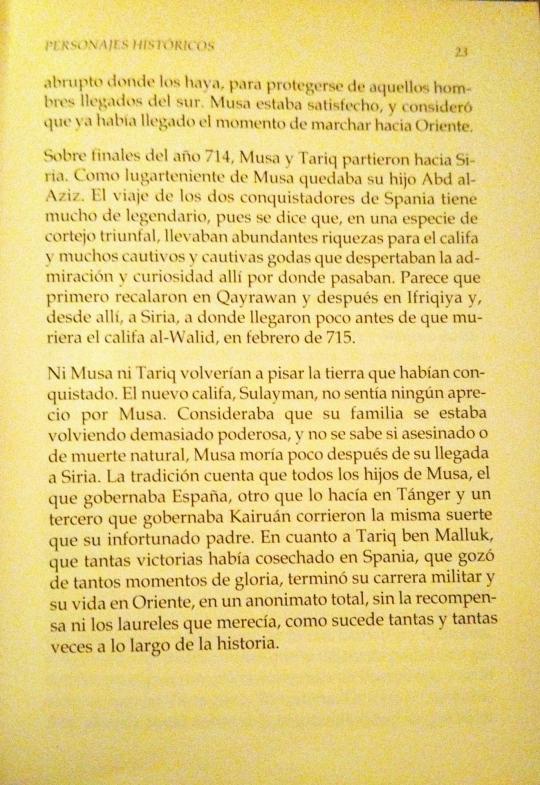
very abrupt, to protect themselves from those men arriving from the south. Musa was satisfied, and considered that the time had come to march towards the East.
Around the end of the year 714, Musa and Tariq left for Syria. Musa's lieutenant was his son Abd al-Aziz. The journey of the two conquerors of Spania is very legendary, since it is said that, in a kind of triumphal procession, they brought abundant riches for the caliph and many Gothic captives who aroused admiration and curiosity wherever they passed. It seems that they first landed in Qayrawan and then in Ifriqiya and, from there, to Syria, where they arrived shortly before the death of the Caliph al-Walid, in February 715.
Neither Musa nor Tariq would return to set foot on the land they had conquered. The new caliph, Sulayman, had no appreciation for Musa. He considered that his family was becoming too powerful, and it is not known whether murdered or a natural death, Musa died shortly after his arrival in Syria. Tradition says that all of Musa's sons, the one who ruled Spania, another who ruled in Tangier and a third who ruled Kairouan, suffered the same fate as their unfortunate father. As for Tarif ben Malluk, who had won so many victories in Spania, who enjoyed so many moments of glory, he ended his military career and his life in the East, in total anonymity, without the reward or laurels he deserved, as happens so many times throughout history.
#bookblr#historyblr#al andalus#al andalus. historical figures#al-andalus. personajes históricos#al andalus history#book scans#the conquest of al-andalus#fath al andalus#la conquista de al andalus#tariq ibn ziyad#musa ibn nusayr#tarif ibn malik#conde don julián#count don julián#julián de ceuta#spanish history
10 notes
·
View notes